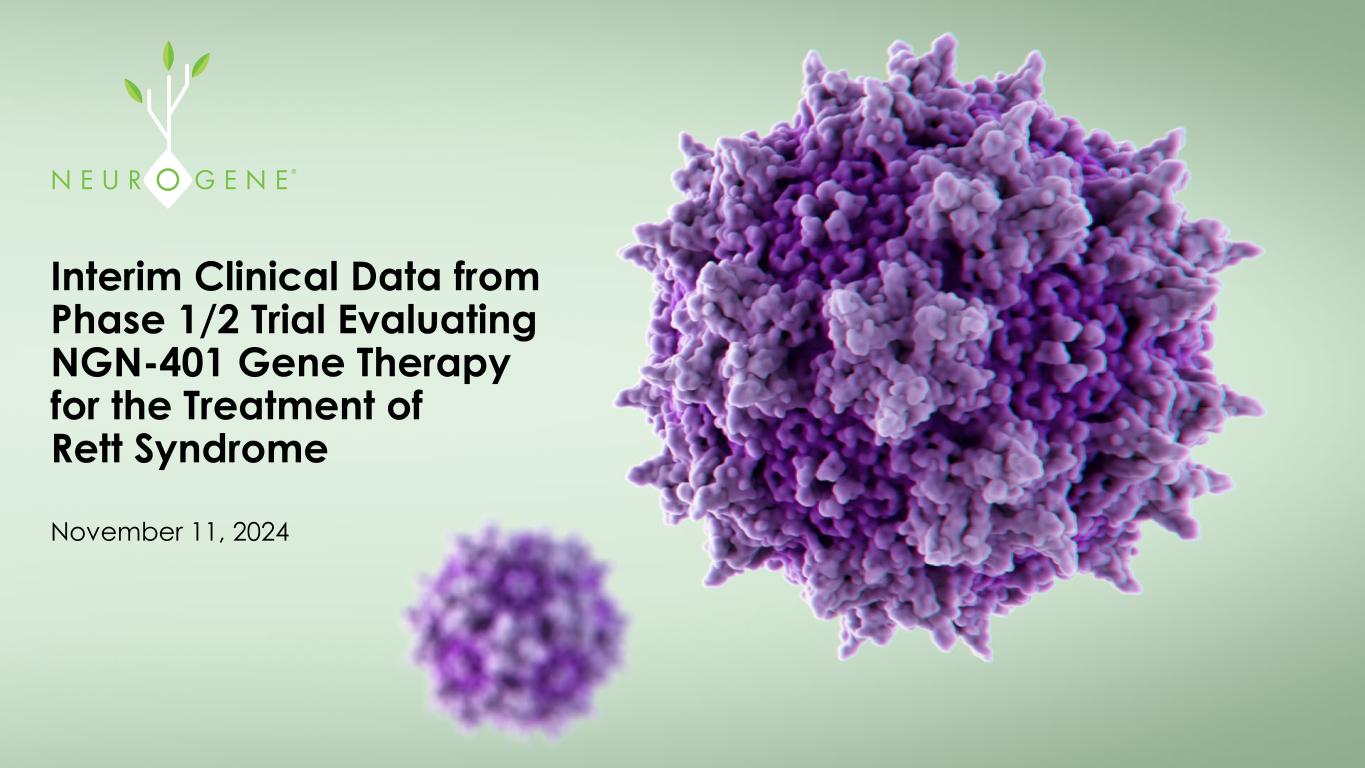
CONFIDENTIAL Interim Clinical Data from Phase 1/2 Trial Evaluating NGN-401 Gene Therapy for the Treatment of Rett Syndrome November 11, 2024
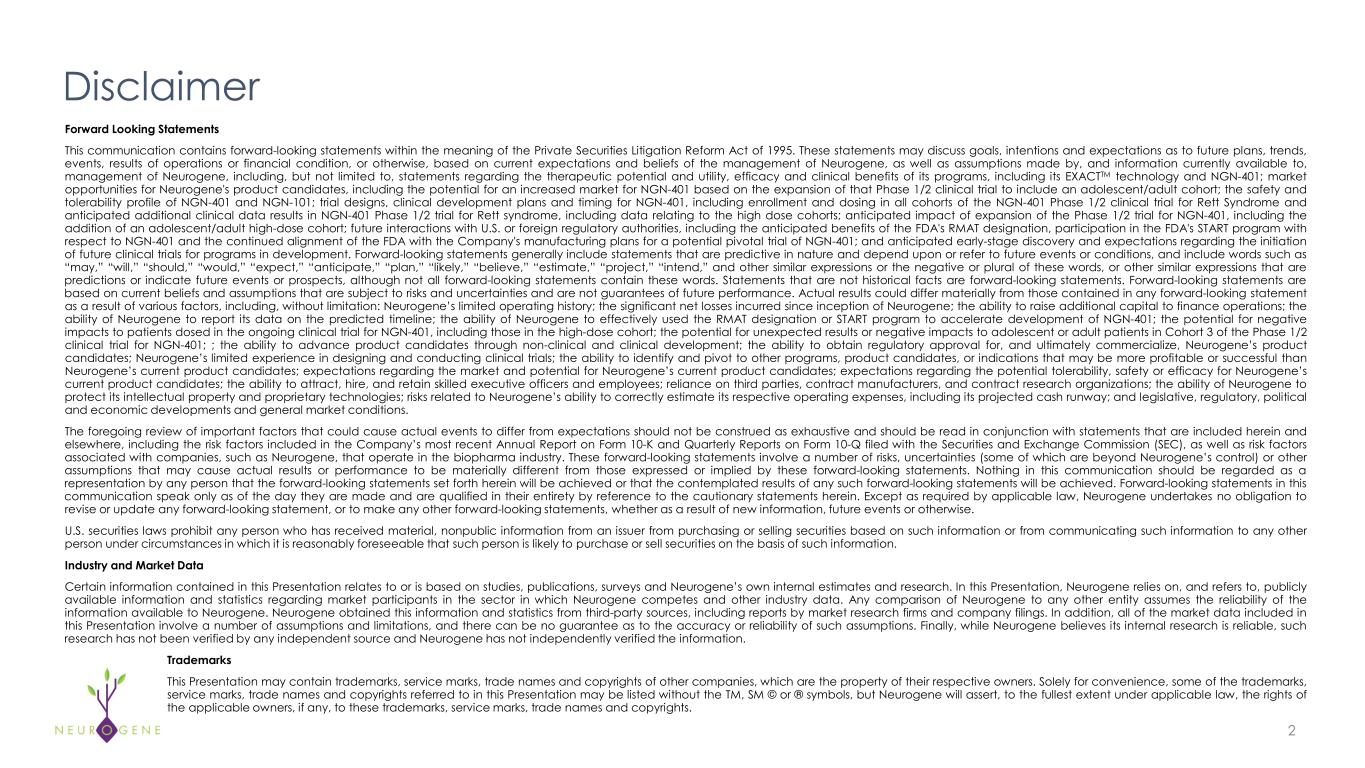
Disclaimer 2 Forward Looking Statements This communication contains forward-looking statements within the meaning of the Private Securities Litigation Reform Act of 1995. These statements may discuss goals, intentions and expectations as to future plans, trends, events, results of operations or financial condition, or otherwise, based on current expectations and beliefs of the management of Neurogene, as well as assumptions made by, and information currently available to, management of Neurogene, including, but not limited to, statements regarding the therapeutic potential and utility, efficacy and clinical benefits of its programs, including its EXACTTM technology and NGN-401; market opportunities for Neurogene's product candidates, including the potential for an increased market for NGN-401 based on the expansion of that Phase 1/2 clinical trial to include an adolescent/adult cohort; the safety and tolerability profile of NGN-401 and NGN-101; trial designs, clinical development plans and timing for NGN-401, including enrollment and dosing in all cohorts of the NGN-401 Phase 1/2 clinical trial for Rett Syndrome and anticipated additional clinical data results in NGN-401 Phase 1/2 trial for Rett syndrome, including data relating to the high dose cohorts; anticipated impact of expansion of the Phase 1/2 trial for NGN-401, including the addition of an adolescent/adult high-dose cohort; future interactions with U.S. or foreign regulatory authorities, including the anticipated benefits of the FDA's RMAT designation, participation in the FDA's START program with respect to NGN-401 and the continued alignment of the FDA with the Company's manufacturing plans for a potential pivotal trial of NGN-401; and anticipated early-stage discovery and expectations regarding the initiation of future clinical trials for programs in development. Forward-looking statements generally include statements that are predictive in nature and depend upon or refer to future events or conditions, and include words such as “may,” “will,” “should,” “would,” “expect,” “anticipate,” “plan,” “likely,” “believe,” “estimate,” “project,” “intend,” and other similar expressions or the negative or plural of these words, or other similar expressions that are predictions or indicate future events or prospects, although not all forward-looking statements contain these words. Statements that are not historical facts are forward-looking statements. Forward-looking statements are based on current beliefs and assumptions that are subject to risks and uncertainties and are not guarantees of future performance. Actual results could differ materially from those contained in any forward-looking statement as a result of various factors, including, without limitation: Neurogene’s limited operating history; the significant net losses incurred since inception of Neurogene; the ability to raise additional capital to finance operations; the ability of Neurogene to report its data on the predicted timeline; the ability of Neurogene to effectively used the RMAT designation or START program to accelerate development of NGN-401; the potential for negative impacts to patients dosed in the ongoing clinical trial for NGN-401, including those in the high-dose cohort; the potential for unexpected results or negative impacts to adolescent or adult patients in Cohort 3 of the Phase 1/2 clinical trial for NGN-401; ; the ability to advance product candidates through non-clinical and clinical development; the ability to obtain regulatory approval for, and ultimately commercialize, Neurogene’s product candidates; Neurogene’s limited experience in designing and conducting clinical trials; the ability to identify and pivot to other programs, product candidates, or indications that may be more profitable or successful than Neurogene’s current product candidates; expectations regarding the market and potential for Neurogene’s current product candidates; expectations regarding the potential tolerability, safety or efficacy for Neurogene’s current product candidates; the ability to attract, hire, and retain skilled executive officers and employees; reliance on third parties, contract manufacturers, and contract research organizations; the ability of Neurogene to protect its intellectual property and proprietary technologies; risks related to Neurogene’s ability to correctly estimate its respective operating expenses, including its projected cash runway; and legislative, regulatory, political and economic developments and general market conditions. The foregoing review of important factors that could cause actual events to differ from expectations should not be construed as exhaustive and should be read in conjunction with statements that are included herein and elsewhere, including the risk factors included in the Company’s most recent Annual Report on Form 10-K and Quarterly Reports on Form 10-Q filed with the Securities and Exchange Commission (SEC), as well as risk factors associated with companies, such as Neurogene, that operate in the biopharma industry. These forward-looking statements involve a number of risks, uncertainties (some of which are beyond Neurogene’s control) or other assumptions that may cause actual results or performance to be materially different from those expressed or implied by these forward-looking statements. Nothing in this communication should be regarded as a representation by any person that the forward-looking statements set forth herein will be achieved or that the contemplated results of any such forward-looking statements will be achieved. Forward-looking statements in this communication speak only as of the day they are made and are qualified in their entirety by reference to the cautionary statements herein. Except as required by applicable law, Neurogene undertakes no obligation to revise or update any forward-looking statement, or to make any other forward-looking statements, whether as a result of new information, future events or otherwise. U.S. securities laws prohibit any person who has received material, nonpublic information from an issuer from purchasing or selling securities based on such information or from communicating such information to any other person under circumstances in which it is reasonably foreseeable that such person is likely to purchase or sell securities on the basis of such information. Industry and Market Data Certain information contained in this Presentation relates to or is based on studies, publications, surveys and Neurogene’s own internal estimates and research. In this Presentation, Neurogene relies on, and refers to, publicly available information and statistics regarding market participants in the sector in which Neurogene competes and other industry data. Any comparison of Neurogene to any other entity assumes the reliability of the information available to Neurogene. Neurogene obtained this information and statistics from third-party sources, including reports by market research firms and company filings. In addition, all of the market data included in this Presentation involve a number of assumptions and limitations, and there can be no guarantee as to the accuracy or reliability of such assumptions. Finally, while Neurogene believes its internal research is reliable, such research has not been verified by any independent source and Neurogene has not independently verified the information. Trademarks This Presentation may contain trademarks, service marks, trade names and copyrights of other companies, which are the property of their respective owners. Solely for convenience, some of the trademarks, service marks, trade names and copyrights referred to in this Presentation may be listed without the TM, SM © or ® symbols, but Neurogene will assert, to the fullest extent under applicable law, the rights of the applicable owners, if any, to these trademarks, service marks, trade names and copyrights.
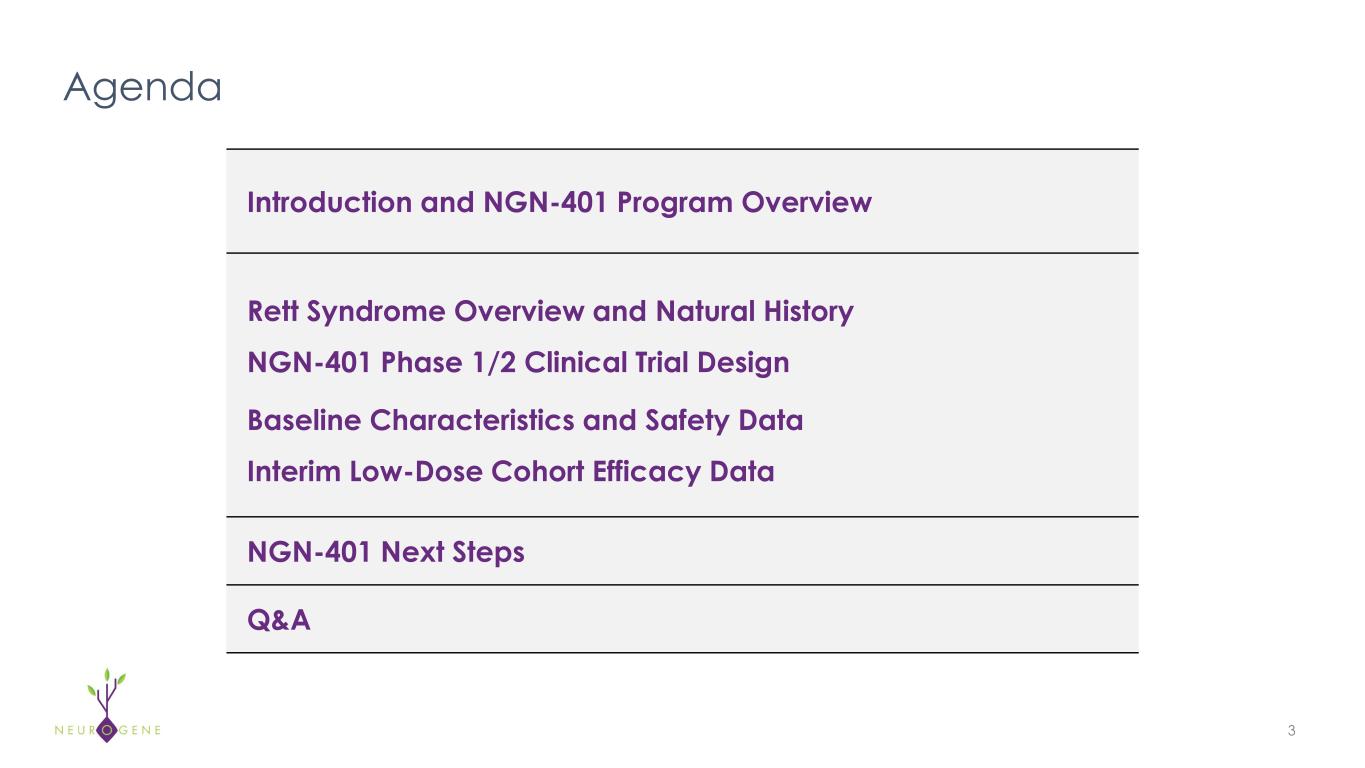
Agenda Introduction and NGN-401 Program Overview Rett Syndrome Overview and Natural History NGN-401 Phase 1/2 Clinical Trial Design Baseline Characteristics and Safety Data Interim Low-Dose Cohort Efficacy Data NGN-401 Next Steps Q&A 3

4

Compelling Interim Clinical Data in Low-Dose Cohort Shows Gains of Function Across Core Domains and Improvements in Autonomic Function 5 NGN-401 Durable improvements observed across multiple scales, incl. two-point improvement in CGI-I in all participants, with concordance of benefit across scales Consistent gains observed across core clinical domains of hand function, gross motor and communication, despite heterogeneous presentation Objective improvements in autonomic domains of sleep and constipation Clinically meaningful gain of skills and developmental milestones beyond those observed in natural history data Rapid response post-treatment, with deepening of response over time Favorable safety profile with low-dose NGN-401 As of data cut-off date of 17 October 2024
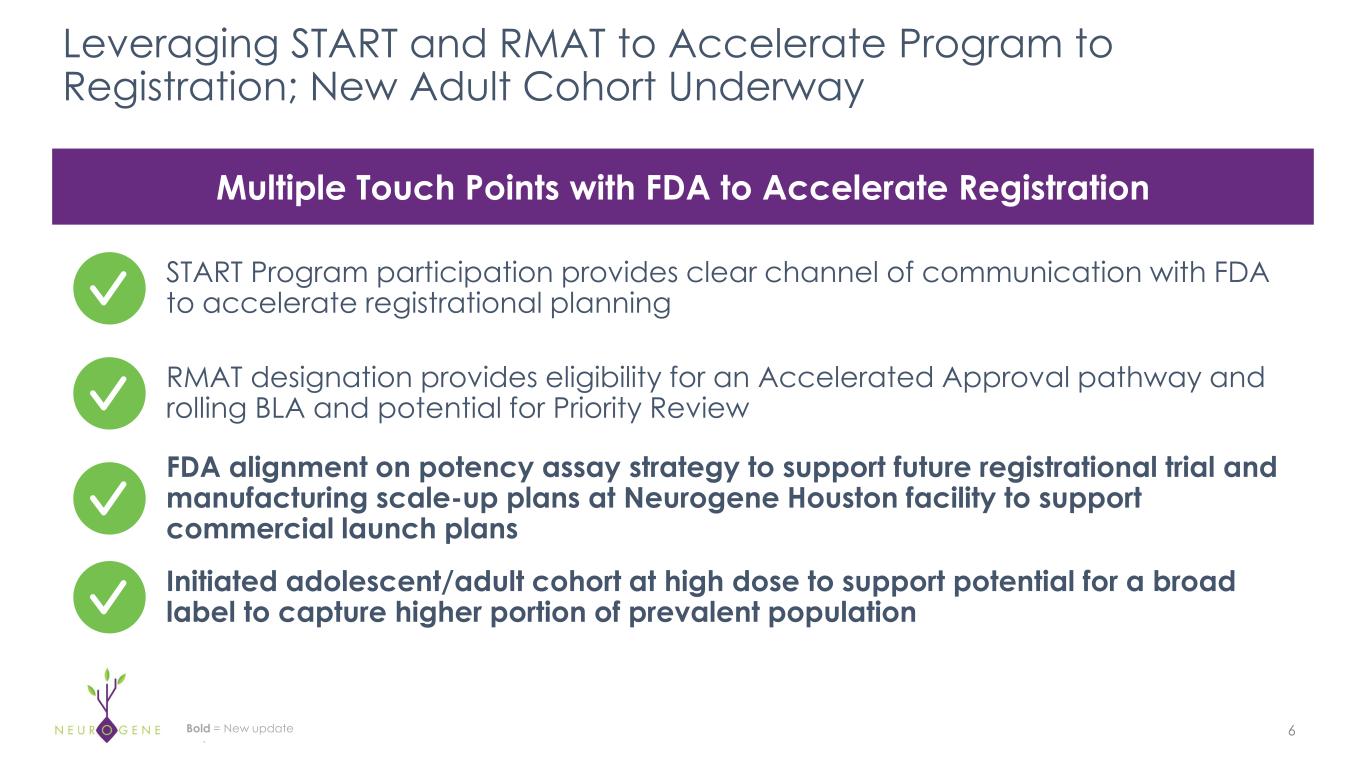
Leveraging START and RMAT to Accelerate Program to Registration; New Adult Cohort Underway 6 START Program participation provides clear channel of communication with FDA to accelerate registrational planning RMAT designation provides eligibility for an Accelerated Approval pathway and rolling BLA and potential for Priority Review FDA alignment on potency assay strategy to support future registrational trial and manufacturing scale-up plans at Neurogene Houston facility to support commercial launch plans Initiated adolescent/adult cohort at high dose to support potential for a broad label to capture higher portion of prevalent population Multiple Touch Points with FDA to Accelerate Registration . Bold = New update
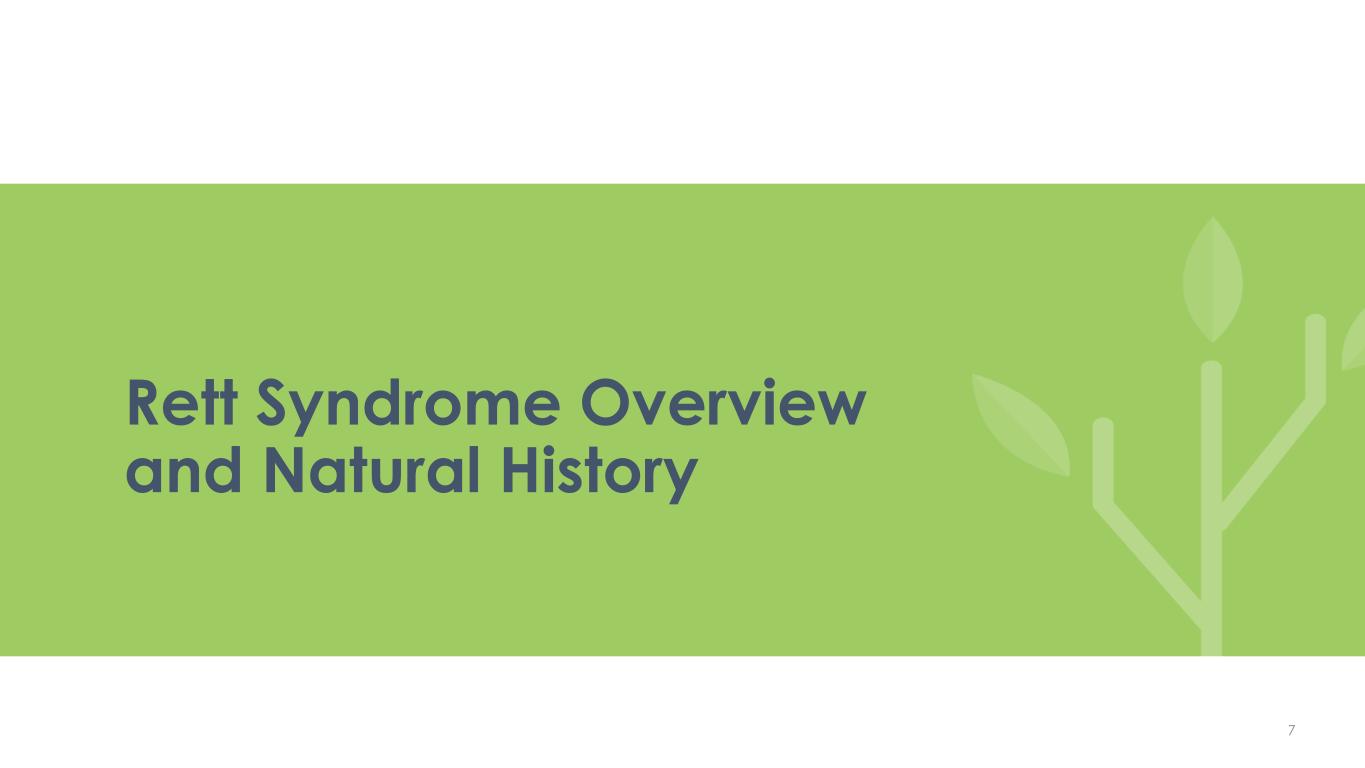
Rett Syndrome Overview and Natural History 7
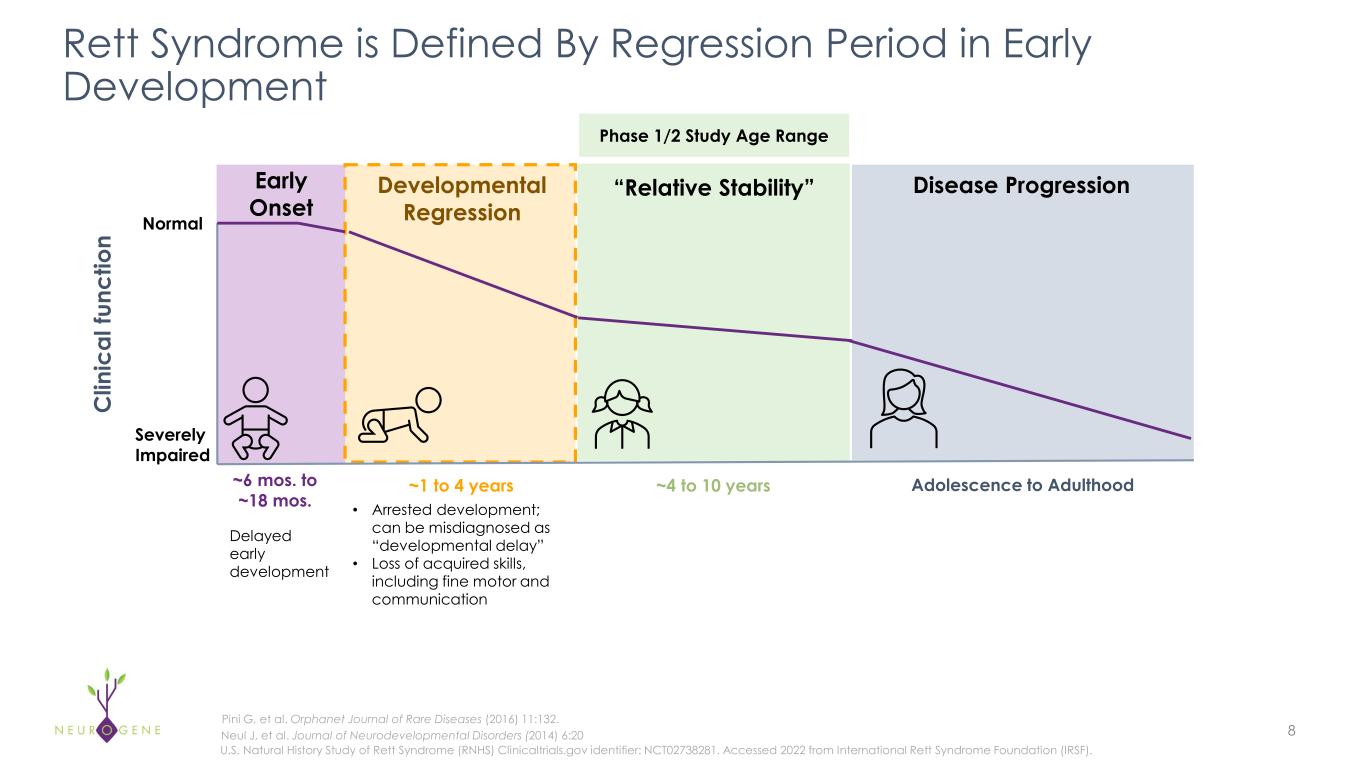
Rett Syndrome is Defined By Regression Period in Early Development 8 Pini G, et al. Orphanet Journal of Rare Diseases (2016) 11:132. C lin ic al fu nc tio n ~6 mos. to ~18 mos. ~1 to 4 years ~4 to 10 years Normal Adolescence to Adulthood Developmental Regression Early Onset Disease Progression“Relative Stability” Severely Impaired Delayed early development • Arrested development; can be misdiagnosed as “developmental delay” • Loss of acquired skills, including fine motor and communication Phase 1/2 Study Age Range U.S. Natural History Study of Rett Syndrome (RNHS) Clinicaltrials.gov identifier: NCT02738281. Accessed 2022 from International Rett Syndrome Foundation (IRSF). Neul J, et al. Journal of Neurodevelopmental Disorders (2014) 6:20
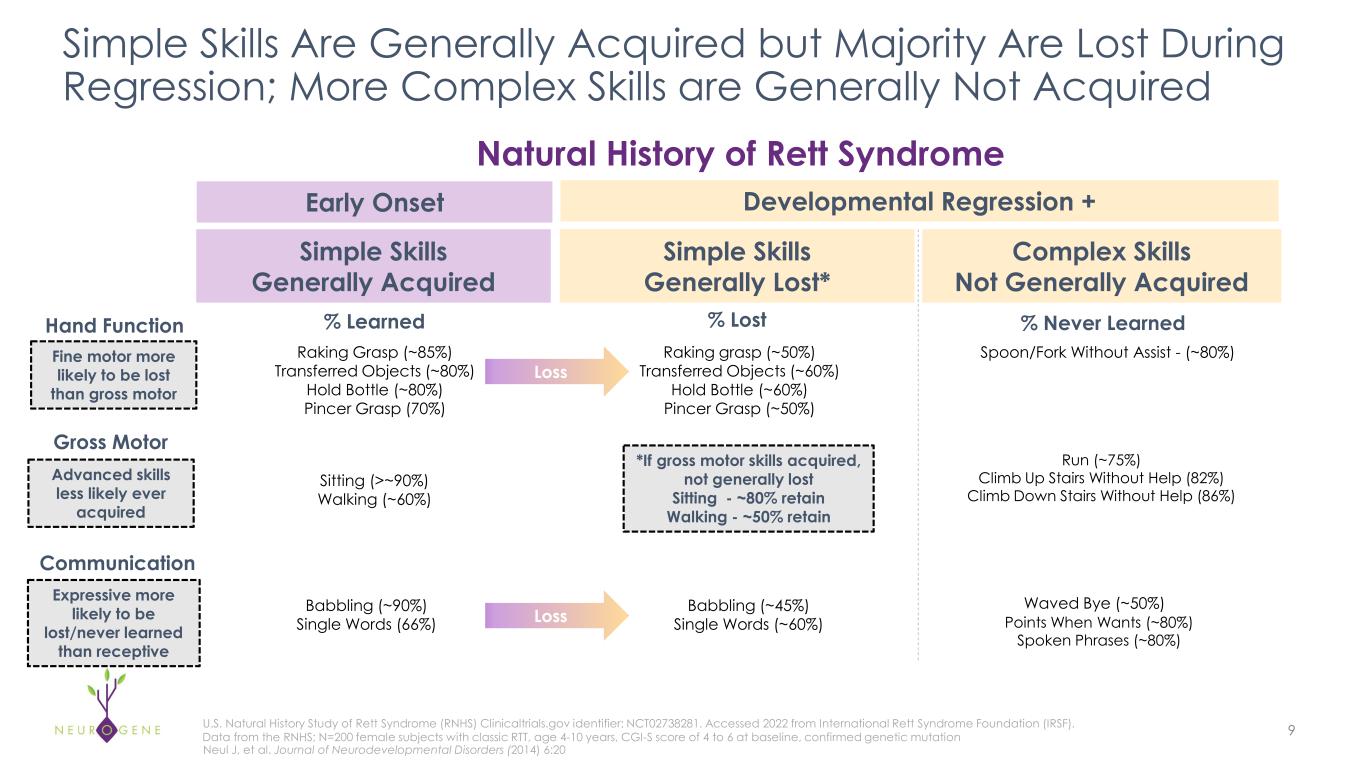
Simple Skills Are Generally Acquired but Majority Are Lost During Regression; More Complex Skills are Generally Not Acquired 9Data from the RNHS; N=200 female subjects with classic RTT, age 4-10 years, CGI-S score of 4 to 6 at baseline, confirmed genetic mutation Raking Grasp (~85%) Transferred Objects (~80%) Hold Bottle (~80%) Pincer Grasp (70%) Points When Wants (~80%) Spoken Phrases (~80%) Hand Function Gross Motor Communication Simple Skills Generally Acquired Simple Skills Generally Lost* Complex Skills Not Generally Acquired Natural History of Rett Syndrome Early Onset Developmental Regression + % Never Learned Spoon/Fork Without Assist - (~80%) % Learned U.S. Natural History Study of Rett Syndrome (RNHS) Clinicaltrials.gov identifier: NCT02738281. Accessed 2022 from International Rett Syndrome Foundation (IRSF). % Lost Sitting (>~90%) Walking (~60%) Run (~75%) Climb Up Stairs Without Help (82%) Climb Down Stairs Without Help (86%) Babbling (~90%) Single Words (66%) Raking grasp (~50%) Transferred Objects (~60%) Hold Bottle (~60%) Pincer Grasp (~50%) Babbling (~45%) Single Words (~60%) *If gross motor skills acquired, not generally lost Sitting - ~80% retain Walking - ~50% retain Fine motor more likely to be lost than gross motor Advanced skills less likely ever acquired Expressive more likely to be lost/never learned than receptive Loss Waved Bye (~50%) Loss Neul J, et al. Journal of Neurodevelopmental Disorders (2014) 6:20
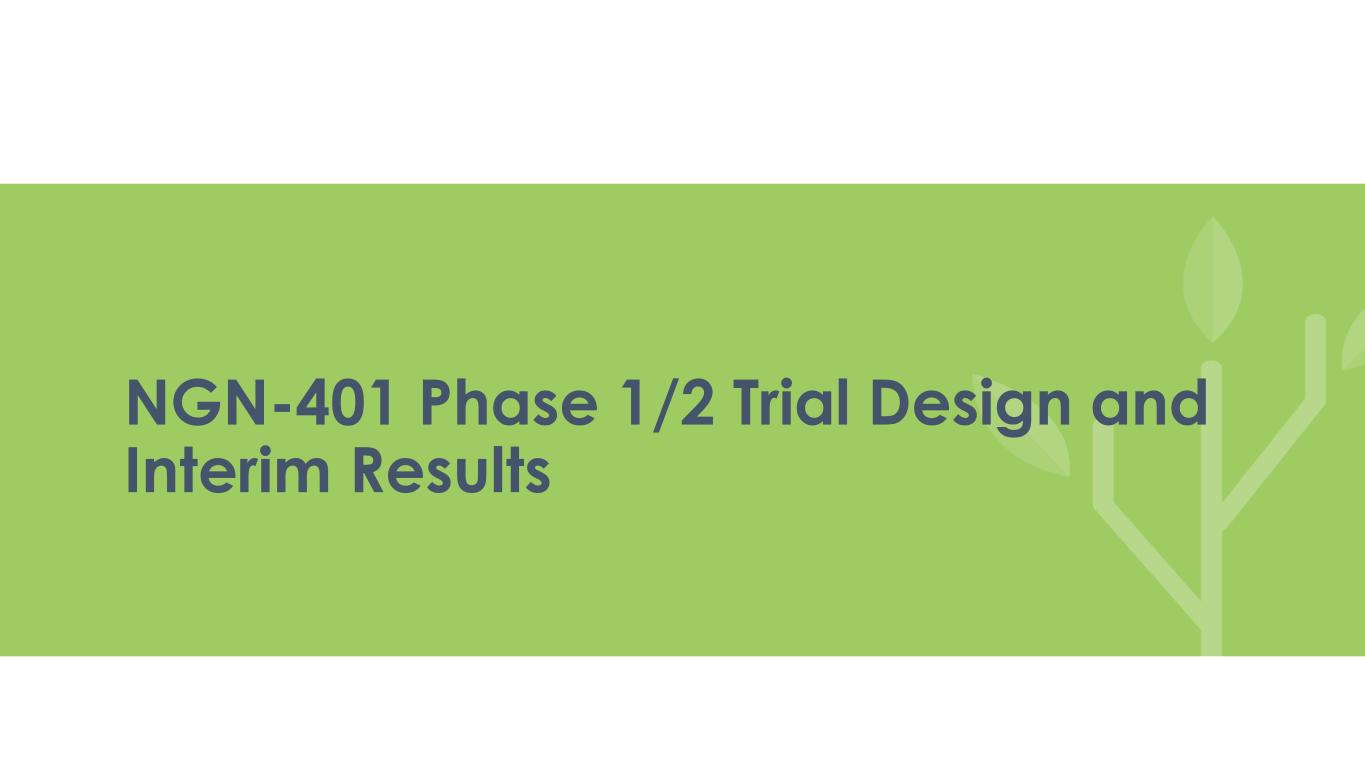
NGN-401 Phase 1/2 Trial Design and Interim Results

NGN-401 Phase 1/2 Clinical Trial Design in Females with Rett Syndrome 11 Cohort 1 prophylactic immunosuppression regimen includes corticosteroids Cohorts 2 and 3 prophylactic immunosuppression regimen includes a targeted regimen of rituximab, sirolimus and shorter course of corticosteroids Trial Design • Females with Classic Rett syndrome in post regression stage of illness • Clinical diagnosis and genetic confirmation of pathogenic MECP2 mutation • Pediatric: 4–10 years old; Adolescent/Adult: 16+ years old • Clinical Global Impression-Severity (CGI-S) score of 4–6 Cohort 2 3E15 vg N=8 Cohort 1 1E15 vg N=8 Pe di at ric A do le sc en t/ A du lt Cohort 3 3E15 vg N=3 Key Eligibility Criteria • Clinician Global Impression-Improvement (CGI-I) • Clinician Global Impression-Severity with Rett syndrome-specific anchors (CGI-S) • Rett Syndrome Behavior Questionnaire (RSBQ) • Autonomic function Key Efficacy Assessments

12 Baseline Characteristics of Dosed Participants Range from Moderate to Severe Disease Low-Dose Cohort 1 (1E15 vg) High-Dose Cohort 2 (3E15 vg) Participant 1 (LD:1) Participant 2 (LD:2) Participant 3 (LD:3) Participant 4 (LD:4) Participant 5 (LD:5) Participant 1 (HD:1) Participant 2 (HD:2) Age at Dosing in Years 7 4 6 7 6 5 7 MECP2 Mutation Severity Mild Severe Severe Severe Severe Severe Unclassified Baseline Disease Severity as Indicated by CGI-S Score 4 (moderately ill) 5 (markedly ill) 5 (markedly ill) 5 (markedly ill) 5 (markedly ill) 5 (markedly ill) 4 (moderately ill) Time Post Treatment with NGN-401 in Months ~15 ~12 ~9 <6 ~1 ~5 ~2 Despite Similar CGI-S Scores, Individual Baseline Presentations Vary Widely Across Core Clinical Domains As of data cut-off date of 17 October 2024
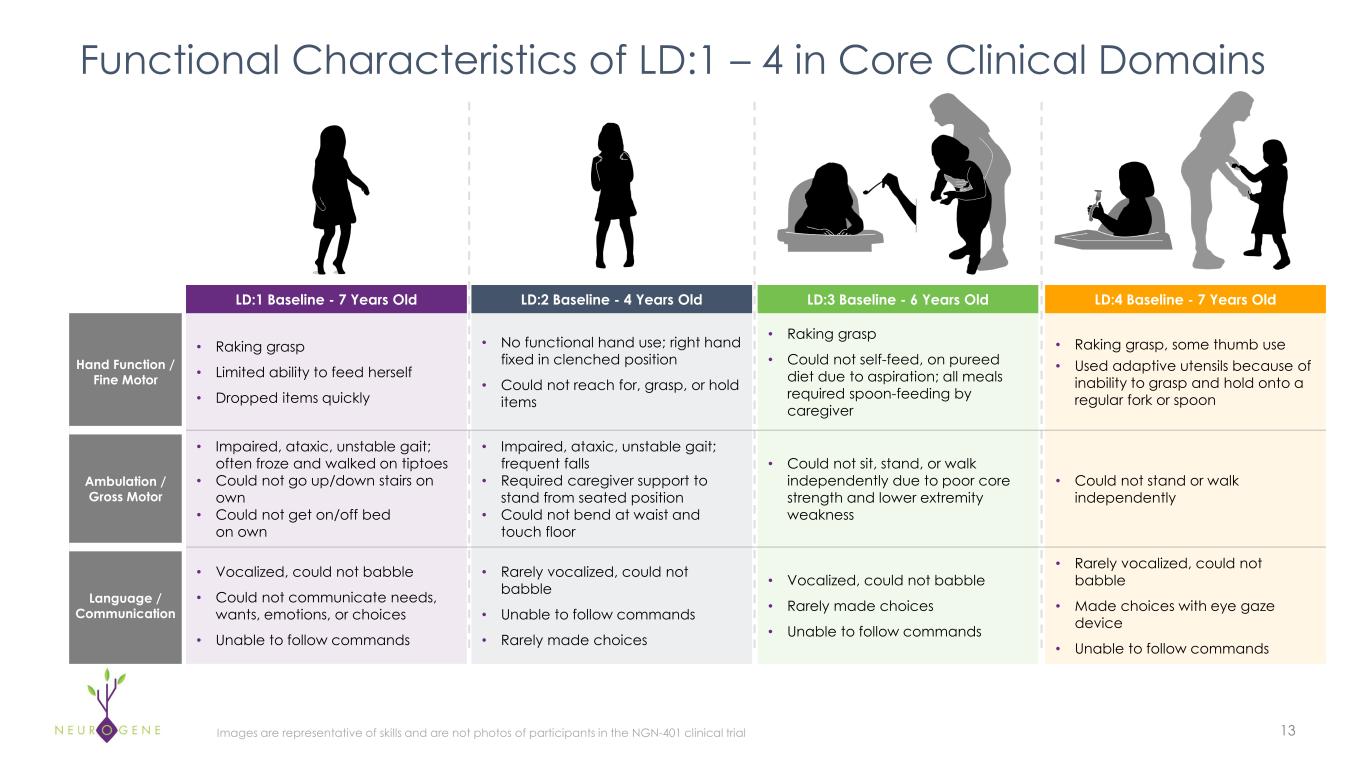
13Images are representative of skills and are not photos of participants in the NGN-401 clinical trial LD:1 Baseline - 7 Years Old LD:2 Baseline - 4 Years Old LD:3 Baseline - 6 Years Old LD:4 Baseline - 7 Years Old Hand Function / Fine Motor • Raking grasp • Limited ability to feed herself • Dropped items quickly • No functional hand use; right hand fixed in clenched position • Could not reach for, grasp, or hold items • Raking grasp • Could not self-feed, on pureed diet due to aspiration; all meals required spoon-feeding by caregiver • Raking grasp, some thumb use • Used adaptive utensils because of inability to grasp and hold onto a regular fork or spoon Ambulation / Gross Motor • Impaired, ataxic, unstable gait; often froze and walked on tiptoes • Could not go up/down stairs on own • Could not get on/off bed on own • Impaired, ataxic, unstable gait; frequent falls • Required caregiver support to stand from seated position • Could not bend at waist and touch floor • Could not sit, stand, or walk independently due to poor core strength and lower extremity weakness • Could not stand or walk independently Language / Communication • Vocalized, could not babble • Could not communicate needs, wants, emotions, or choices • Unable to follow commands • Rarely vocalized, could not babble • Unable to follow commands • Rarely made choices • Vocalized, could not babble • Rarely made choices • Unable to follow commands • Rarely vocalized, could not babble • Made choices with eye gaze device • Unable to follow commands Functional Characteristics of LD:1 – 4 in Core Clinical Domains
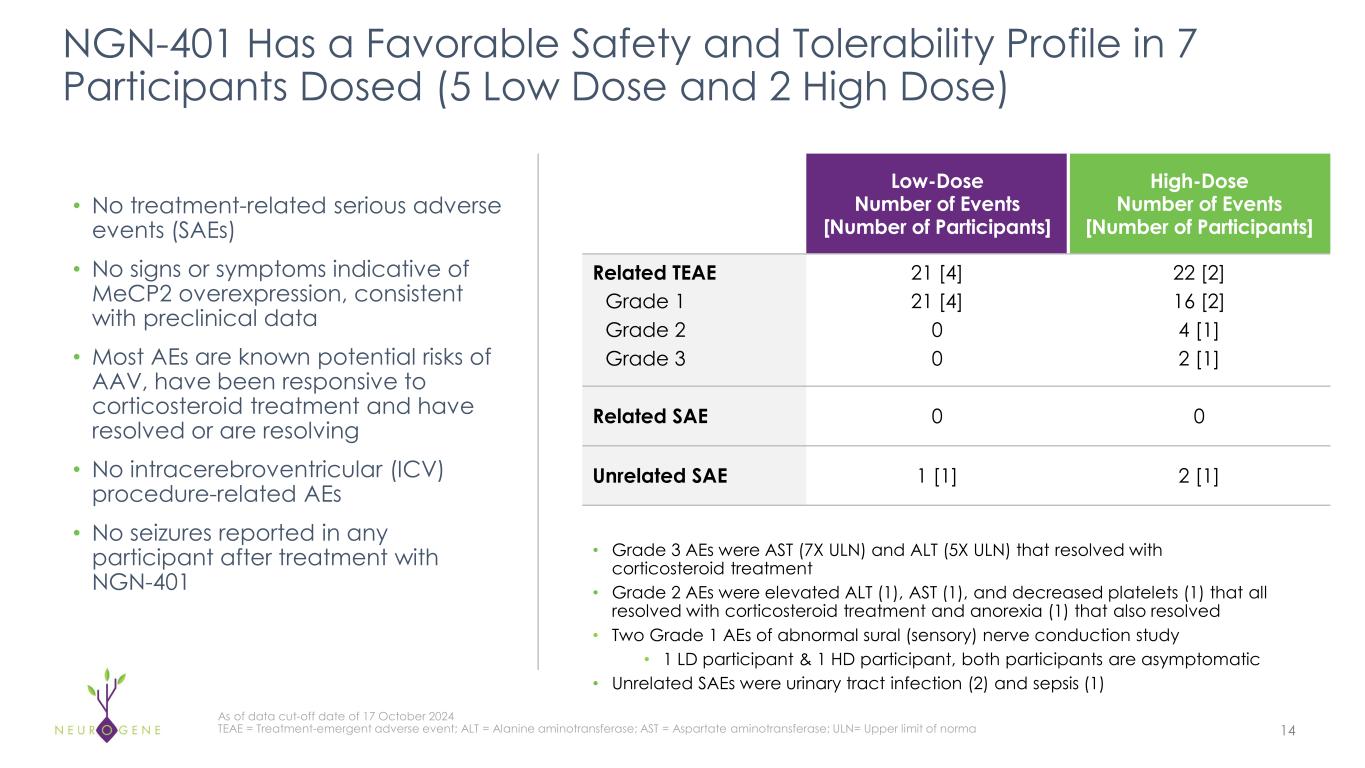
14 As of data cut-off date of 17 October 2024 TEAE = Treatment-emergent adverse event; ALT = Alanine aminotransferase; AST = Aspartate aminotransferase; ULN= Upper limit of norma NGN-401 Has a Favorable Safety and Tolerability Profile in 7 Participants Dosed (5 Low Dose and 2 High Dose) Low-Dose Number of Events [Number of Participants] High-Dose Number of Events [Number of Participants] Related TEAE Grade 1 Grade 2 Grade 3 21 [4] 21 [4] 0 0 22 [2] 16 [2] 4 [1] 2 [1] Related SAE 0 0 Unrelated SAE 1 [1] 2 [1] • Grade 3 AEs were AST (7X ULN) and ALT (5X ULN) that resolved with corticosteroid treatment • Grade 2 AEs were elevated ALT (1), AST (1), and decreased platelets (1) that all resolved with corticosteroid treatment and anorexia (1) that also resolved • Two Grade 1 AEs of abnormal sural (sensory) nerve conduction study • 1 LD participant & 1 HD participant, both participants are asymptomatic • Unrelated SAEs were urinary tract infection (2) and sepsis (1) • No treatment-related serious adverse events (SAEs) • No signs or symptoms indicative of MeCP2 overexpression, consistent with preclinical data • Most AEs are known potential risks of AAV, have been responsive to corticosteroid treatment and have resolved or are resolving • No intracerebroventricular (ICV) procedure-related AEs • No seizures reported in any participant after treatment with NGN-401

Consistent Improvement Across Key Rett Syndrome Scales, Bolstered by Functional Improvements in Core Clinical Domains 15 As of data cut-off date of 17 October 2024 *Each participant achieved a 2-point improvement from “no change,” or a score of 4 CGI-I CGI-S Total Score RSBQ Improved? How many points?* Improved? How many points? Improved? How many points? (% Change) LD:1 15 mos. post-NGN- 401 2 pts. 10 pts. (-28%) LD:2 12 mos. post-NGN- 401 2 pts. 1 pt. 32 pts. (-52%) LD:3 9 mos. post-NGN- 401 2 pts. 5 pts. (-29%) LD:4 3 mos. post-NGN- 401 2 pts. 8 pts. (-28%) Gain of Skills, Developmental Milestones and Symptom Improvement in RTT Clinical Domains Hand Function Gross Motor Communi- cation Autonomic Attentive- ness
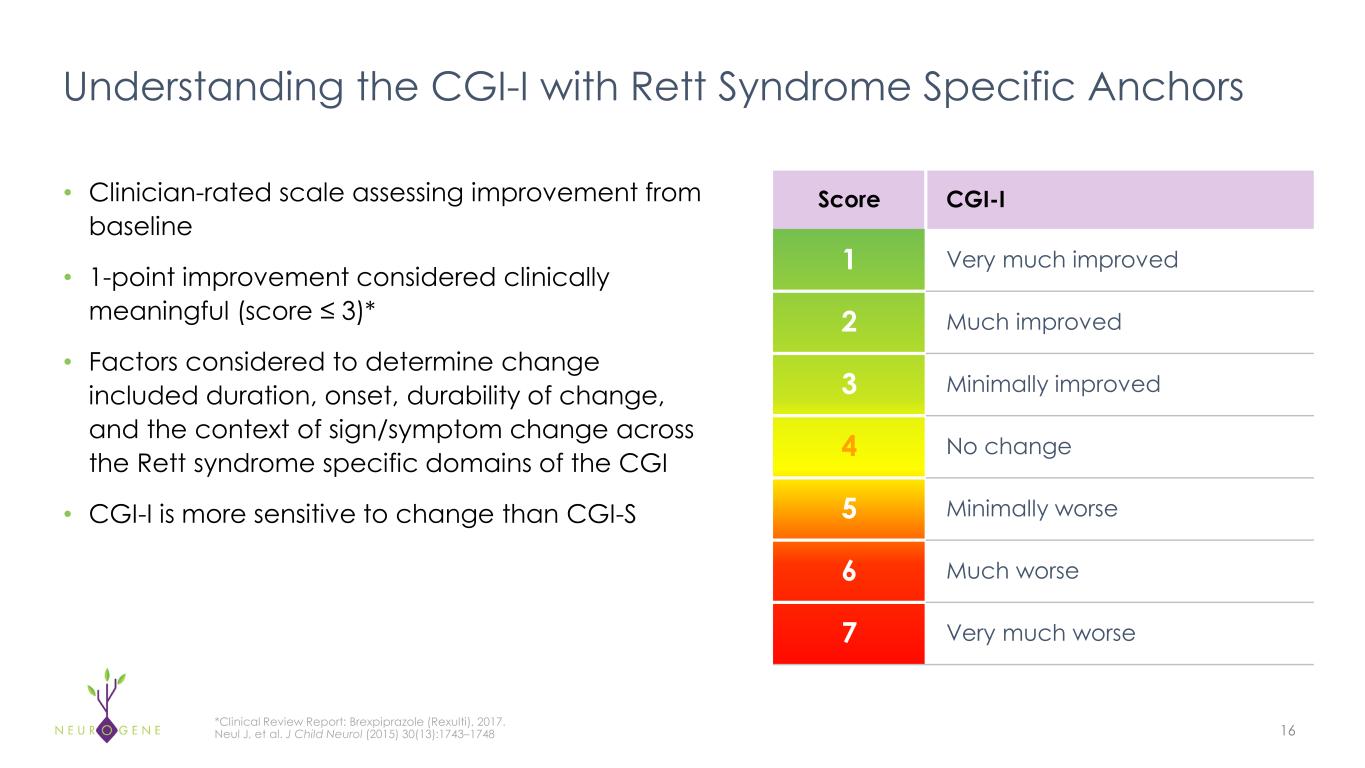
Understanding the CGI-I with Rett Syndrome Specific Anchors 16*Clinical Review Report: Brexpiprazole (Rexulti), 2017. Neul J, et al. J Child Neurol (2015) 30(13):1743–1748 • Clinician-rated scale assessing improvement from baseline • 1-point improvement considered clinically meaningful (score ≤ 3)* • Factors considered to determine change included duration, onset, durability of change, and the context of sign/symptom change across the Rett syndrome specific domains of the CGI • CGI-I is more sensitive to change than CGI-S Score CGI-I 1 Very much improved 2 Much improved 3 Minimally improved 4 No change 5 Minimally worse 6 Much worse 7 Very much worse

All Treated Participants Achieved CGI-I Rating of “Much Improved” CGI-I Score ≤ 3 = Clinically Meaningful Improvement LD:1 3 – Minimally Improved 2 – Much Improved 2 – Much Improved 2 – Much Improved 2 – Much Improved LD:2 2 – Much Improved 2 – Much Improved 2 – Much Improved 2 – Much Improved LD:3 3 – Minimally Improved 3 – Minimally Improved 2 – Much Improved LD:4 2 – Much Improved 3 mos. 6 mos. 9 mos. 12 mos. 15 mos. 17 Post Treatment with NGN-401 As of data cut-off date of 17 October 2024 Clinically Meaningful Improvement Observed Early After Treatment, with Deepening Response and Durability Over Time
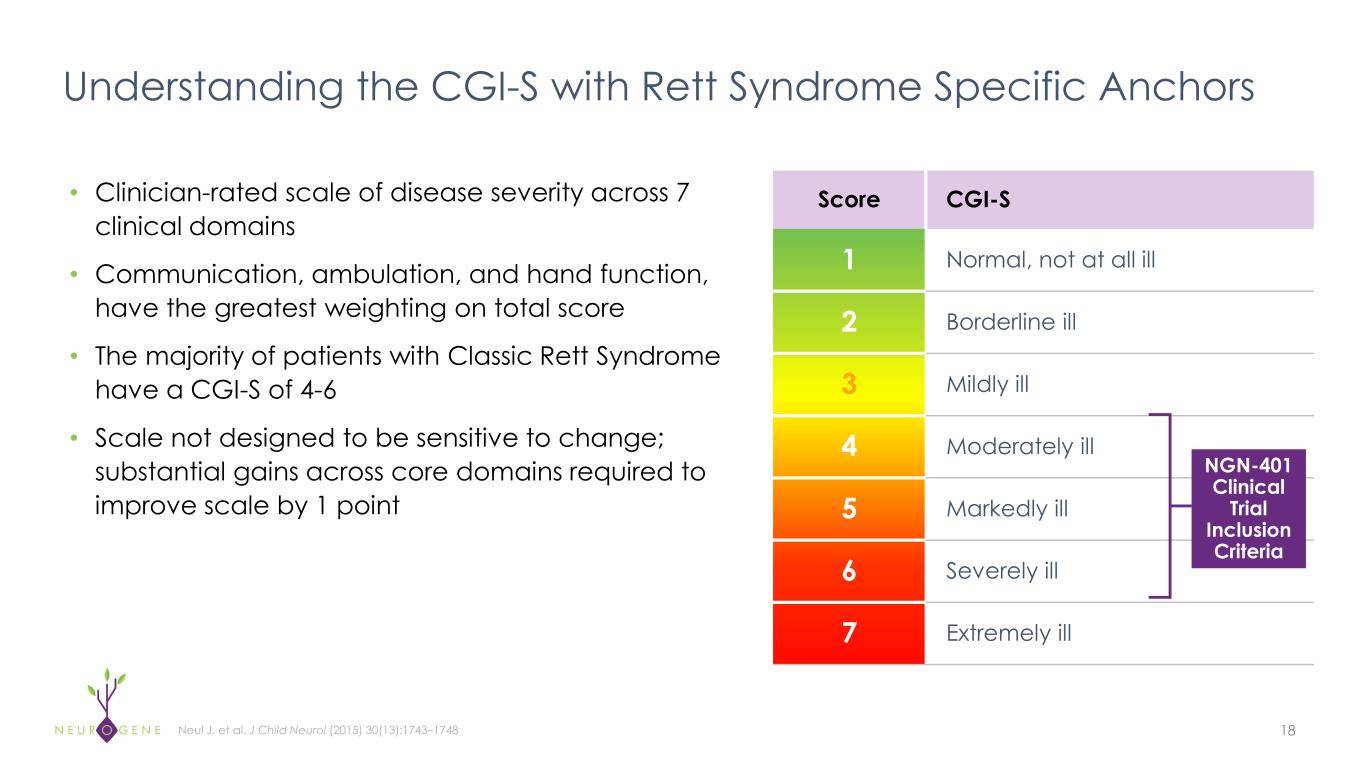
Score CGI-S 1 Normal, not at all ill 2 Borderline ill 3 Mildly ill 4 Moderately ill 5 Markedly ill 6 Severely ill 7 Extremely ill Understanding the CGI-S with Rett Syndrome Specific Anchors 18 • Clinician-rated scale of disease severity across 7 clinical domains • Communication, ambulation, and hand function, have the greatest weighting on total score • The majority of patients with Classic Rett Syndrome have a CGI-S of 4-6 • Scale not designed to be sensitive to change; substantial gains across core domains required to improve scale by 1 point NGN-401 Clinical Trial Inclusion Criteria Neul J, et al. J Child Neurol (2015) 30(13):1743–1748

CGI-S Clinical Domains Provide Insights Into Core Functional Areas; Scale Was Not Designed as Clinical Outcome Measure 19*Treated participants to date have been stable with no seizures on study Neul J, et al. J Child Neurol (2015) 30(13):1743–1748 Clinical Domains CGI-S 3 CGI-S 4 CGI-S 5 CGI-S 6 Language/ Communication Phrases-sentences. May have conversations or echolalia <5 words Babbles Makes choices 25%-50% No words Babbles Makes choices ≤25% Vocalizations Occasionally screams Rarely or makes no choices Ambulation Walks, able to use stairs/run May ride tricycle or climb Walks independently Unable to use stairs or run Walks with assistance Stands with support or independently May walk with support Sits independently or with support Hand use Bilateral pincer grasp. May use pen to write but has fine motor issues like tremor Reaches for objects, raking grasp or unilateral pincer May use utensils/cup Reaches No grasps Rarely-occasionally reaches out No grasp Social (eye contact) Appropriate eye contact, >30s Eye contact <20s Eye contact <10s Eye contact, inconsistent 5s Autonomic No or minimal breathing abnormalities (<5%) warm, pink extremities Breathing dysrhythmia <50% No cynanosis Cool UE, Pink LE Breathing dysrhythmia 50% No cynanosis Cold UE, Pink LE Breathing dysrhythmia 50- 100% May have cynanosis Cool UE or LE, may be blue Seizures* None, with or without meds Monthly-weekly Weekly Weekly-daily Attentiveness Attentive to conversation, follows commands 50-100% 50% <50% Core functional domains Key clinical focus is breathing abnormalities Following commands clinically meaningful
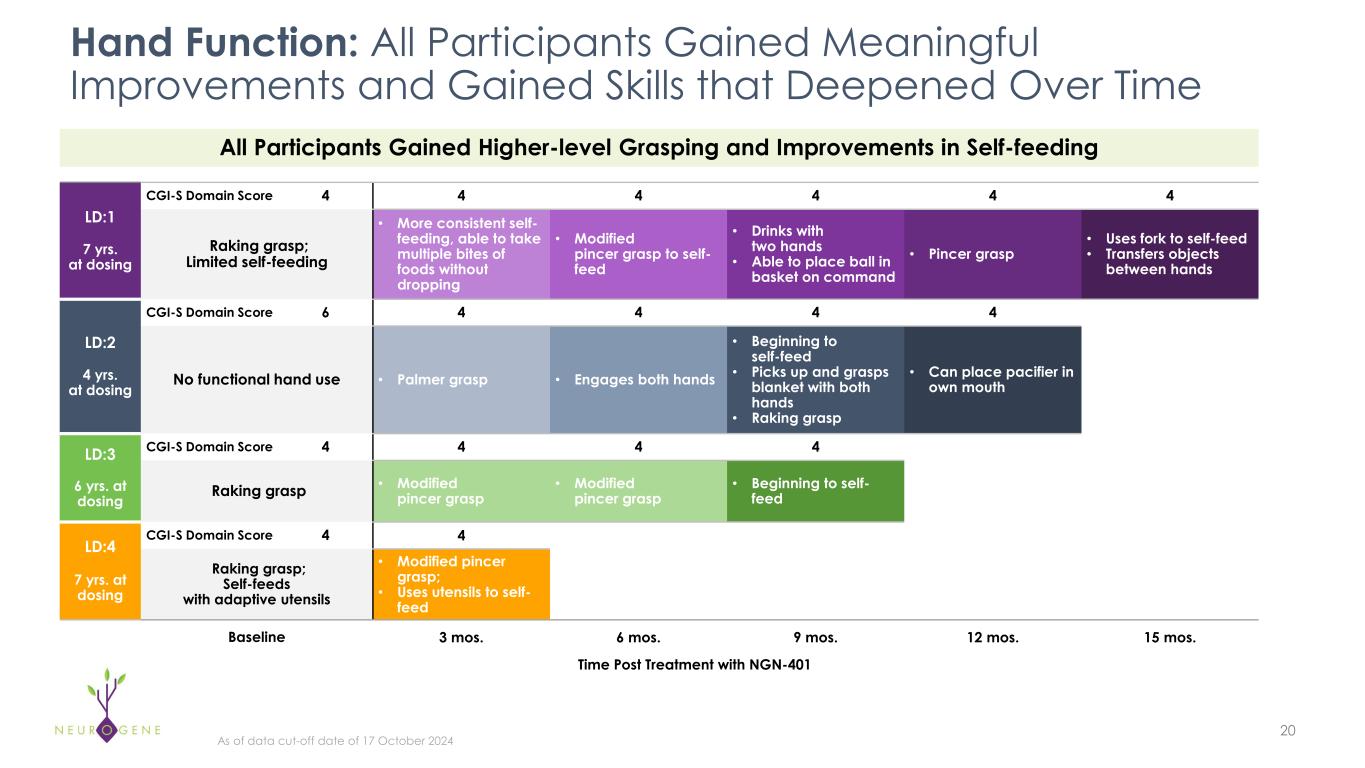
Hand Function: All Participants Gained Meaningful Improvements and Gained Skills that Deepened Over Time 20 LD:1 7 yrs. at dosing CGI-S Domain Score 4 4 4 4 4 4 Raking grasp; Limited self-feeding • More consistent self- feeding, able to take multiple bites of foods without dropping • Modified pincer grasp to self- feed • Drinks with two hands • Able to place ball in basket on command • Pincer grasp • Uses fork to self-feed • Transfers objects between hands LD:2 4 yrs. at dosing CGI-S Domain Score 6 4 4 4 4 No functional hand use • Palmer grasp • Engages both hands • Beginning to self-feed • Picks up and grasps blanket with both hands • Raking grasp • Can place pacifier in own mouth LD:3 6 yrs. at dosing CGI-S Domain Score 4 4 4 4 Raking grasp • Modified pincer grasp • Modified pincer grasp • Beginning to self- feed LD:4 7 yrs. at dosing CGI-S Domain Score 4 4 Raking grasp; Self-feeds with adaptive utensils • Modified pincer grasp; • Uses utensils to self- feed Baseline 3 mos. 6 mos. 9 mos. 12 mos. 15 mos. All Participants Gained Higher-level Grasping and Improvements in Self-feeding As of data cut-off date of 17 October 2024 Time Post Treatment with NGN-401
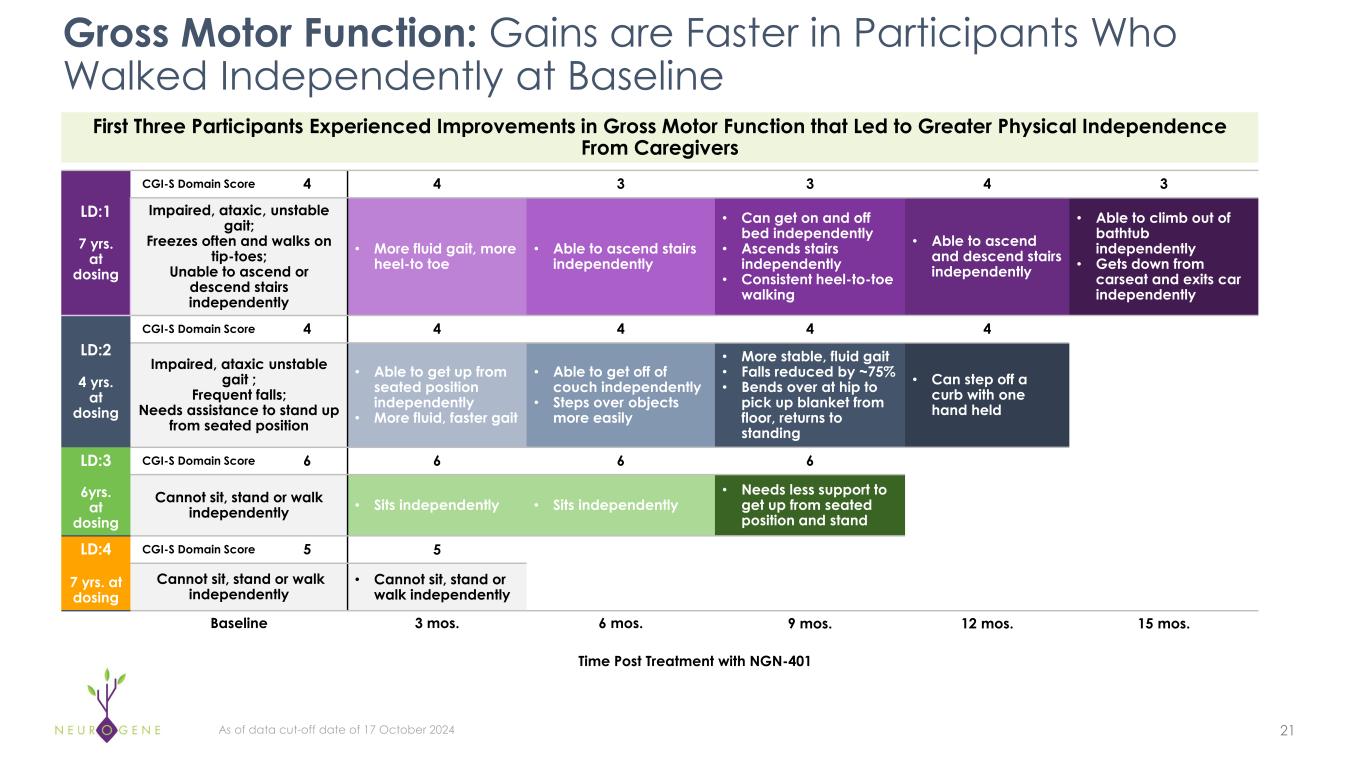
21 LD:1 7 yrs. at dosing CGI-S Domain Score 4 4 3 3 4 3 Impaired, ataxic, unstable gait; Freezes often and walks on tip-toes; Unable to ascend or descend stairs independently • More fluid gait, more heel-to toe • Able to ascend stairs independently • Can get on and off bed independently • Ascends stairs independently • Consistent heel-to-toe walking • Able to ascend and descend stairs independently • Able to climb out of bathtub independently • Gets down from carseat and exits car independently LD:2 4 yrs. at dosing CGI-S Domain Score 4 4 4 4 4 Impaired, ataxic unstable gait ; Frequent falls; Needs assistance to stand up from seated position • Able to get up from seated position independently • More fluid, faster gait • Able to get off of couch independently • Steps over objects more easily • More stable, fluid gait • Falls reduced by ~75% • Bends over at hip to pick up blanket from floor, returns to standing • Can step off a curb with one hand held LD:3 6yrs. at dosing CGI-S Domain Score 6 6 6 6 Cannot sit, stand or walk independently • Sits independently • Sits independently • Needs less support to get up from seated position and stand LD:4 7 yrs. at dosing CGI-S Domain Score 5 5 Cannot sit, stand or walk independently • Cannot sit, stand or walk independently Baseline 3 mos. 6 mos. 9 mos. 12 mos. 15 mos. First Three Participants Experienced Improvements in Gross Motor Function that Led to Greater Physical Independence From Caregivers Gross Motor Function: Gains are Faster in Participants Who Walked Independently at Baseline Time Post Treatment with NGN-401 As of data cut-off date of 17 October 2024

Communication: All Participants Demonstrated Improvement in Ability to Convey Choices (Slide 1 of 2) 22 LD:1 7 yrs. at dosing CGI-S Domain Score 6 6 5 5 4 4 Makes choices 50% of time; Unable to follow commands • Some choice-making • Makes choices most of time; food 80–90% of time • Intermittently follows commands • Makes choices nearly 100% of time for food • Follows multiple commands • Makes choices 100% of time for food • Taps food items she wants • Follows >10 commands, many without gesture • Consistently makes choices for food • Follows >10 commands, many without gesture • Actively seeks attention from others LD:2 4 yrs. at dosing CGI-S Domain Score 6 5 4 4 4 Rarely makes choices; Unable to follow commands • Makes choices 25–50% of time • Makes choices 25–50% of time • Makes food choices 50–75% of time • Follows simple commands • Makes choices 50% of time • Follows simple commands LD:3 6yrs. at dosing CGI-S Domain Score 6 6 6 6 Rarely makes choices; Unable to follow commands • Makes choices 50% of time • Makes choices 25% of time • Makes choices <25% of the time LD:4 7 yrs. at dosing CGI-S Domain Score 4 5 Makes choices with eye gaze device; Unable to follow commands • Makes choices ~25% of time Baseline 3 mos. 6 mos. 9 mos. 12 mos. 15 mos. Time Post Treatment with NGN-401 Ability to Follow Caregiver Commands Demonstrated in Patients With Longest Follow Up As of data cut-off date of 17 October 2024

Communication: All Participants Experiencing Improvements in Ability to Express Themselves (Slide 2 of 2) 23 LD:1 7 yrs. at dosing CGI-S Domain Score 6 6 5 5 4 4 Vocalizations • Vocalizations • Vocalizations • Vocalizations • Babbles • Consistently waves “hello” on command • Shouts or yells to express emotions when unhappy or uncomfortable LD:2 4 yrs. at dosing CGI-S Domain Score 6 5 4 4 4 Vocalizations • Occasional babbling, “dada” for Daddy • Says “mama” and “dada” clearly • Says “mama,” “dada” and “nana” purposefully and in context • Says “mama,” “dada” and “nana” purposefully and in context LD:3 6yrs. at dosing CGI-S Domain Score 6 6 6 6 Vocalizations • Increased Vocalizations • Increased Vocalizations • Laughs when caregiver makes jokes playing with toys LD:4 7 yrs. at dosing CGI-S Domain Score 4 5 Vocalizations • Laughs at jokes when watching a movie • Vocalizations to express discomfort or protest Baseline 3 mos. 6 mos. 9 mos. 12 mos. 15 mos. Time Post Treatment with NGN-401 As of data cut-off date of 17 October 2024
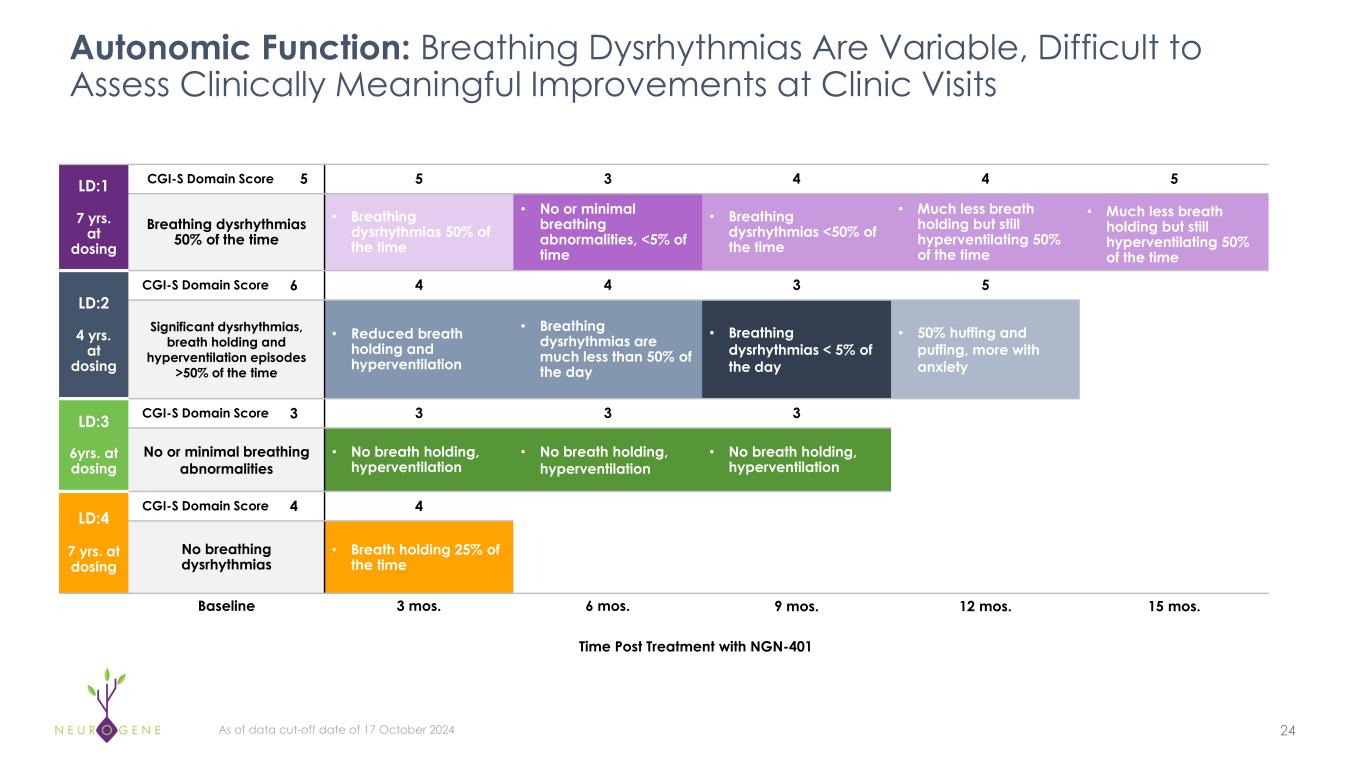
Autonomic Function: Breathing Dysrhythmias Are Variable, Difficult to Assess Clinically Meaningful Improvements at Clinic Visits 24 LD:1 7 yrs. at dosing CGI-S Domain Score 5 5 3 4 4 5 Breathing dysrhythmias 50% of the time • Breathing dysrhythmias 50% of the time • No or minimal breathing abnormalities, <5% of time • Breathing dysrhythmias <50% of the time • Much less breath holding but still hyperventilating 50% of the time • Much less breath holding but still hyperventilating 50% of the time LD:2 4 yrs. at dosing CGI-S Domain Score 6 4 4 3 5 Significant dysrhythmias, breath holding and hyperventilation episodes >50% of the time • Reduced breath holding and hyperventilation • Breathing dysrhythmias are much less than 50% of the day • Breathing dysrhythmias < 5% of the day • 50% huffing and puffing, more with anxiety LD:3 6yrs. at dosing CGI-S Domain Score 3 3 3 3 No or minimal breathing abnormalities • No breath holding, hyperventilation • No breath holding, hyperventilation • No breath holding, hyperventilation LD:4 7 yrs. at dosing CGI-S Domain Score 4 4 No breathing dysrhythmias • Breath holding 25% of the time Baseline 3 mos. 6 mos. 9 mos. 12 mos. 15 mos. As of data cut-off date of 17 October 2024 Time Post Treatment with NGN-401
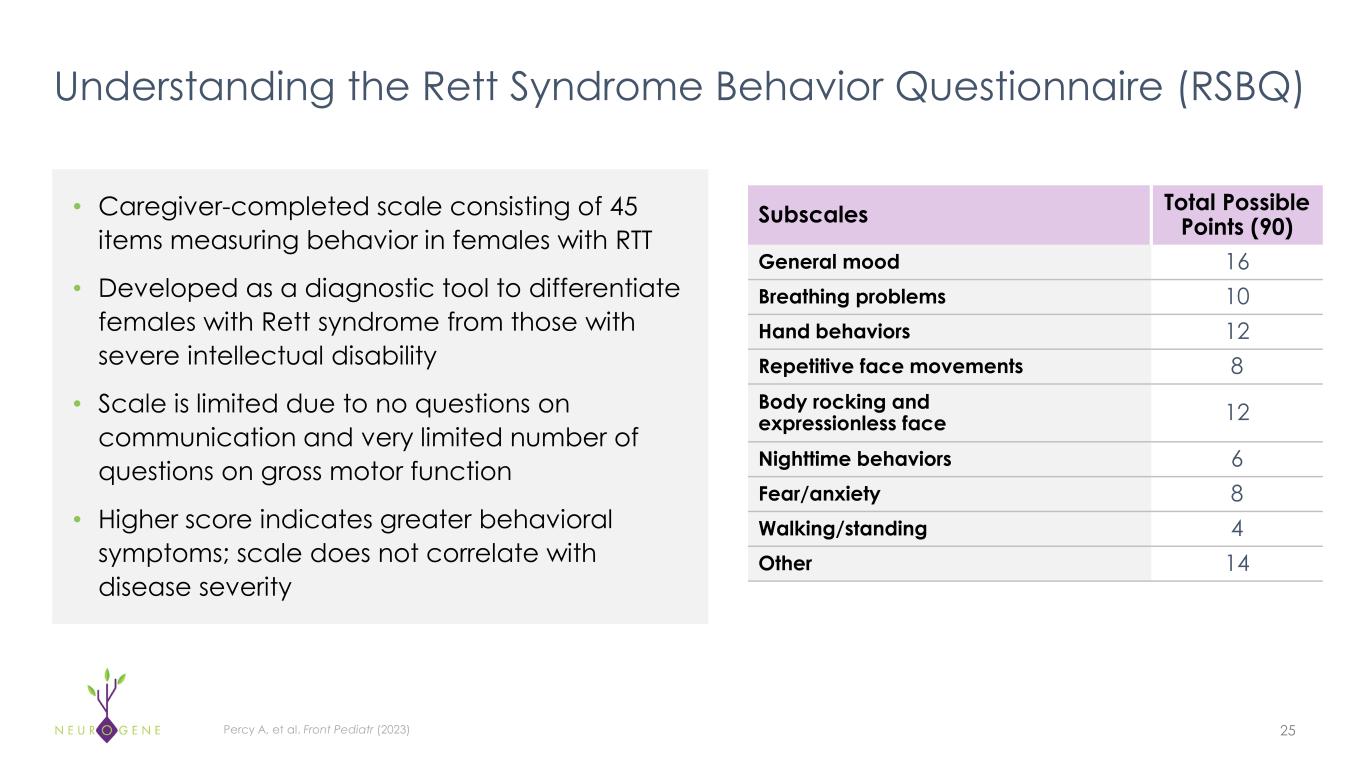
Understanding the Rett Syndrome Behavior Questionnaire (RSBQ) • Caregiver-completed scale consisting of 45 items measuring behavior in females with RTT • Developed as a diagnostic tool to differentiate females with Rett syndrome from those with severe intellectual disability • Scale is limited due to no questions on communication and very limited number of questions on gross motor function • Higher score indicates greater behavioral symptoms; scale does not correlate with disease severity 25Percy A, et al. Front Pediatr (2023) Subscales Total Possible Points (90) General mood 16 Breathing problems 10 Hand behaviors 12 Repetitive face movements 8 Body rocking and expressionless face 12 Nighttime behaviors 6 Fear/anxiety 8 Walking/standing 4 Other 14
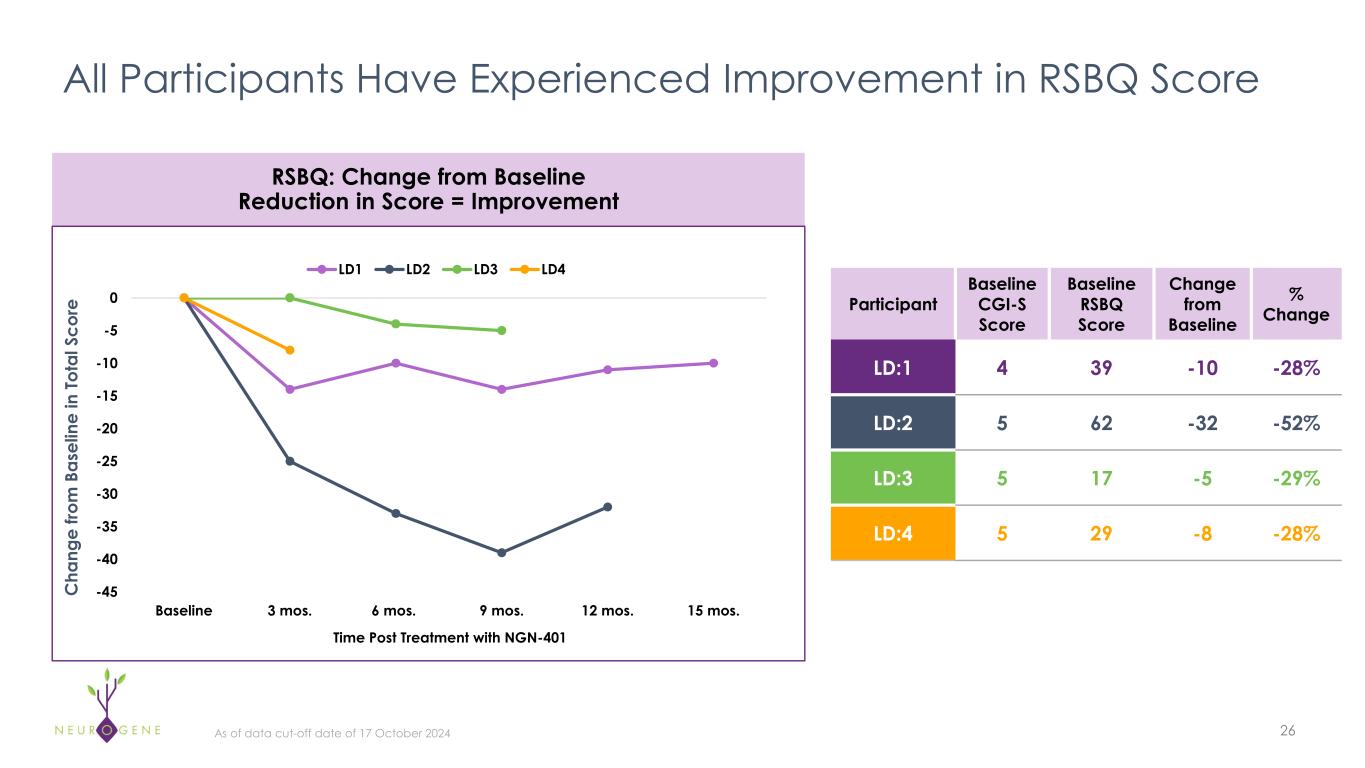
All Participants Have Experienced Improvement in RSBQ Score C ha ng e fro m B as el in e in To ta l S co re 26 Participant Baseline CGI-S Score Baseline RSBQ Score Change from Baseline % Change LD:1 4 39 -10 -28% LD:2 5 62 -32 -52% LD:3 5 17 -5 -29% LD:4 5 29 -8 -28% RSBQ: Change from Baseline Reduction in Score = Improvement -45 -40 -35 -30 -25 -20 -15 -10 -5 0 Baseline 3 mos. 6 mos. 9 mos. 12 mos. 15 mos. LD1 LD2 LD3 LD4 Time Post Treatment with NGN-401 As of data cut-off date of 17 October 2024

All Participants Experienced Improvements in Autonomic Function, as Measured by Objective Assessments 27Detailed data provided in Appendix • LD:1 and LD:2, who had sleep deficits at Baseline, experienced improvements in sleep parameters, as measured by a wearable device • LD:1 sleep efficiency increased from 83% to 90% at 6 months • LD:2 sleep efficiency increased from 90% to >95% at 6 months, considered ideal • LD:1, LD:2 and LD:4 had constipation at Baseline, and experienced improvements over time as measured by the caregiver-reported modified Bristol Stool Form Scale • LD:3 had dysphagia, or difficulty swallowing, at Baseline, requiring a pureed diet and had to be spoon-fed by caregiver due to aspiration; she is now able to swallow liquids from a cup and chew and swallow food items

Participant Vignettes

Hand Function / Fine Motor • Had a raking grasp, briefly held objects, dropping items quickly, with limited ability to self-feed Ambulation / Gross Motor • Walked independently, but would stay on her tip-toes, freeze often and required a parent to help her go up/down stairs or get on/off a bed Language / Communication • Unable to indicate her wishes, follow simple commands from her parents, or express emotion LD:1 From Pre-Treatment to 15 Months Post NGN-401 29 Baseline (7 years old) Post Treatment with NGN-401 Images are representative of skills and are not photos of participants in the NGN-401 clinical trial As of data cut-off date of 17 October 2024 • Developed a pincer grasp, able to self-feed, has begun using a fork to eat; uses both hands to drink on her own • More fluid gait with heel to toe walking, and does the following on her own: goes up/down the stairs, climbs out of high rimmed bathtub, gets on/off furniture, climbs out of her car seat to exit the car • Without being told, navigates her house to the car to go to school, waves hello to her grandfather on daily video calls, taps on food items to express choices, frowns/shouts to show displeasure • Follows >10 commands such as “give a kiss,” “sit down,” “give it to me,” “put item in trash,” “open/close door,” “flush toilet”
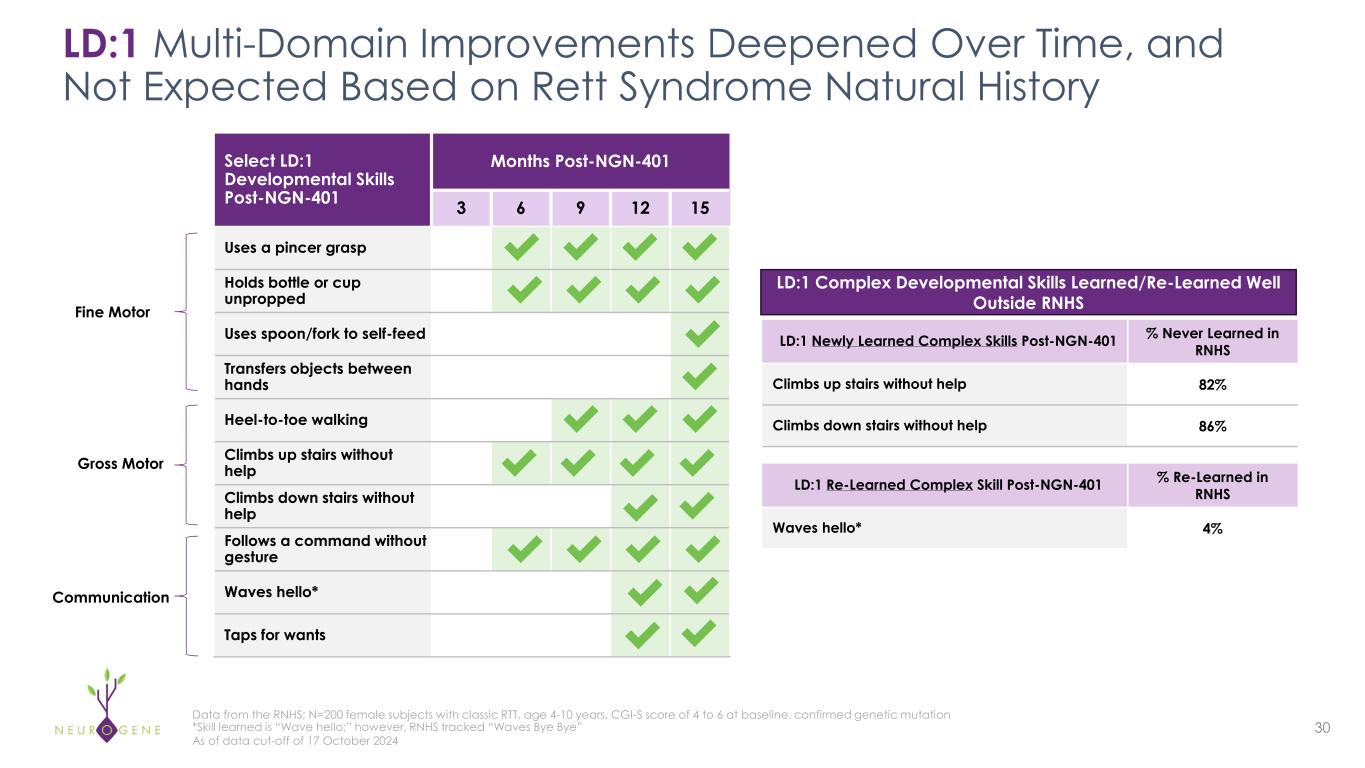
LD:1 Multi-Domain Improvements Deepened Over Time, and Not Expected Based on Rett Syndrome Natural History 30 Select LD:1 Developmental Skills Post-NGN-401 Months Post-NGN-401 3 6 9 12 15 Uses a pincer grasp Holds bottle or cup unpropped Uses spoon/fork to self-feed Transfers objects between hands Heel-to-toe walking Climbs up stairs without help Climbs down stairs without help Follows a command without gesture Waves hello* Taps for wants Data from the RNHS; N=200 female subjects with classic RTT, age 4-10 years, CGI-S score of 4 to 6 at baseline, confirmed genetic mutation *Skill learned is “Wave hello;” however, RNHS tracked “Waves Bye Bye” As of data cut-off of 17 October 2024 LD:1 Newly Learned Complex Skills Post-NGN-401 % Never Learned in RNHS Climbs up stairs without help 82% Climbs down stairs without help 86% LD:1 Re-Learned Complex Skill Post-NGN-401 % Re-Learned in RNHS Waves hello* 4% LD:1 Complex Developmental Skills Learned/Re-Learned Well Outside RNHSFine Motor Gross Motor Communication
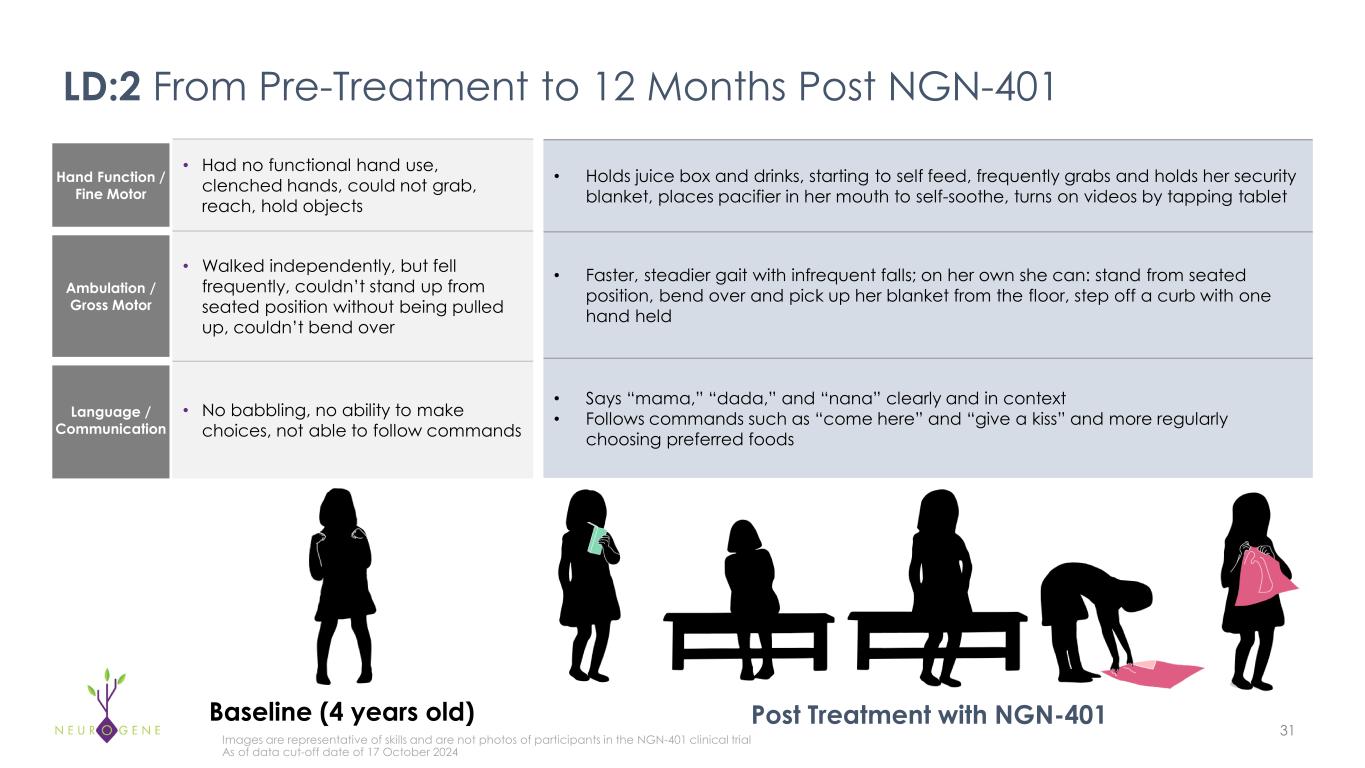
Hand Function / Fine Motor • Had no functional hand use, clenched hands, could not grab, reach, hold objects Ambulation / Gross Motor • Walked independently, but fell frequently, couldn’t stand up from seated position without being pulled up, couldn’t bend over Language / Communication • No babbling, no ability to make choices, not able to follow commands 31 Images are representative of skills and are not photos of participants in the NGN-401 clinical trial As of data cut-off date of 17 October 2024 • Holds juice box and drinks, starting to self feed, frequently grabs and holds her security blanket, places pacifier in her mouth to self-soothe, turns on videos by tapping tablet • Faster, steadier gait with infrequent falls; on her own she can: stand from seated position, bend over and pick up her blanket from the floor, step off a curb with one hand held • Says “mama,” “dada,” and “nana” clearly and in context • Follows commands such as “come here” and “give a kiss” and more regularly choosing preferred foods LD:2 From Pre-Treatment to 12 Months Post NGN-401 Post Treatment with NGN-401Baseline (4 years old)

LD:2 Multi-Domain Improvements from Severe Impairments at Baseline Deepened Over Time, and Not Expected Based on Rett Syndrome Natural History 32 Data from the RNHS; N=200 female subjects with classic RTT, age 4-10 years, CGI-S score of 4 to 6 at baseline, confirmed genetic mutation As of data cut-off date of 17 October 2024 Select LD:2 Developmental Skills Post-NGN-401 Months Post-NGN-401 3 6 9 12 Reaches for an object Uses raking grasp to retrieve an object Self-feeds Stands independently from seated position Bends down, touches floor, and recovers Steps off curb with help Follows a command without a gesture Uses words with meaning LD:2 Newly Learned Complex Skills Post-NGN-401 % Never Learned in RNHS Follows a command without a gesture 64% LD:2 Re-Learned Skills Post-NGN-401 % Re-Learned in RNHS Uses raking grasp to retrieve an object 3% Reaches for an object 13% Uses words with meaning 8% LD:2 Developmental Skills Learned/Re-Learned Well Outside RNHSFine Motor Gross Motor Communication
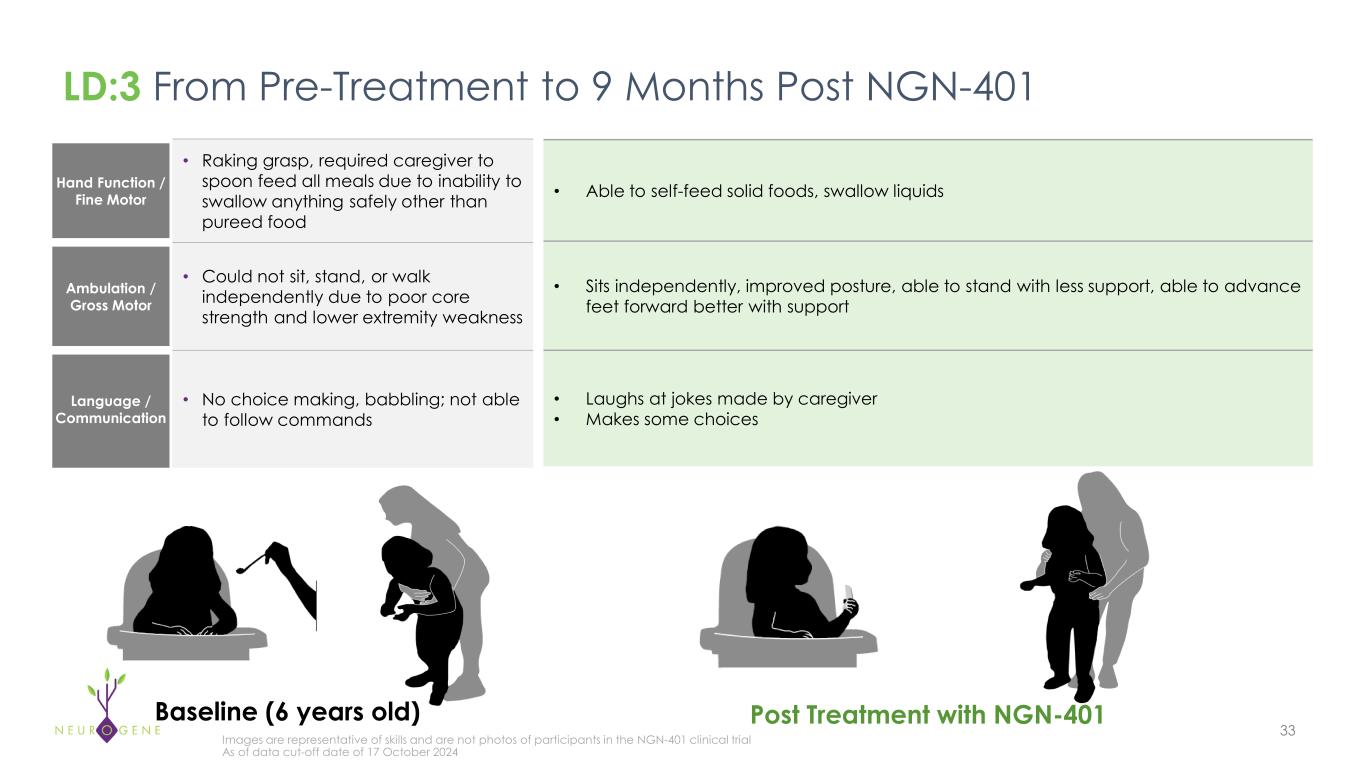
Hand Function / Fine Motor • Raking grasp, required caregiver to spoon feed all meals due to inability to swallow anything safely other than pureed food Ambulation / Gross Motor • Could not sit, stand, or walk independently due to poor core strength and lower extremity weakness Language / Communication • No choice making, babbling; not able to follow commands 33 Images are representative of skills and are not photos of participants in the NGN-401 clinical trial As of data cut-off date of 17 October 2024 • Able to self-feed solid foods, swallow liquids • Sits independently, improved posture, able to stand with less support, able to advance feet forward better with support • Laughs at jokes made by caregiver • Makes some choices LD:3 From Pre-Treatment to 9 Months Post NGN-401 Baseline (6 years old) Post Treatment with NGN-401

LD:3 Multi-Domain Improvements Not Expected Based on Rett Syndrome Natural History 34 Select LD:3 Developmental Skills Months Post-NGN-401 3 6 9 Uses a pincer grasp Able to self-feed Sits independently Data from the RNHS; N=200 female subjects with classic RTT, age 4-10 years, CGI-S score of 4 to 6 at baseline, confirmed genetic mutation As of data cut-off date of 17 October 2024 LD:3 Re-Learned Skills Post-NGN-401 % Re-Learned in RNHS Uses a pincer grasp 6% Able to self-feed 8% Sits independently 7% LD:3 Developmental Re-Learned Well Outside RNHS Fine Motor Gross Motor
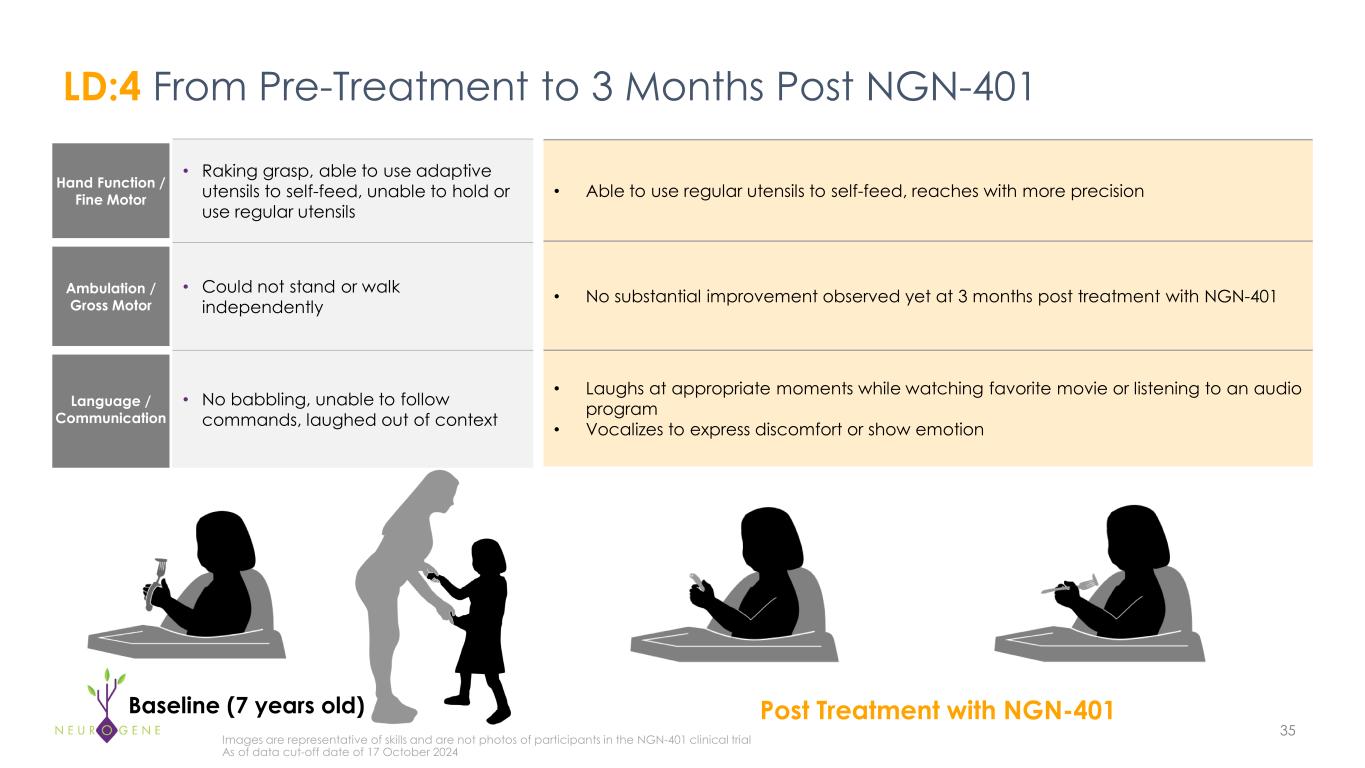
Hand Function / Fine Motor • Raking grasp, able to use adaptive utensils to self-feed, unable to hold or use regular utensils Ambulation / Gross Motor • Could not stand or walk independently Language / Communication • No babbling, unable to follow commands, laughed out of context 35 Images are representative of skills and are not photos of participants in the NGN-401 clinical trial As of data cut-off date of 17 October 2024 • Able to use regular utensils to self-feed, reaches with more precision • No substantial improvement observed yet at 3 months post treatment with NGN-401 • Laughs at appropriate moments while watching favorite movie or listening to an audio program • Vocalizes to express discomfort or show emotion LD:4 From Pre-Treatment to 3 Months Post NGN-401 Baseline (7 years old) Post Treatment with NGN-401
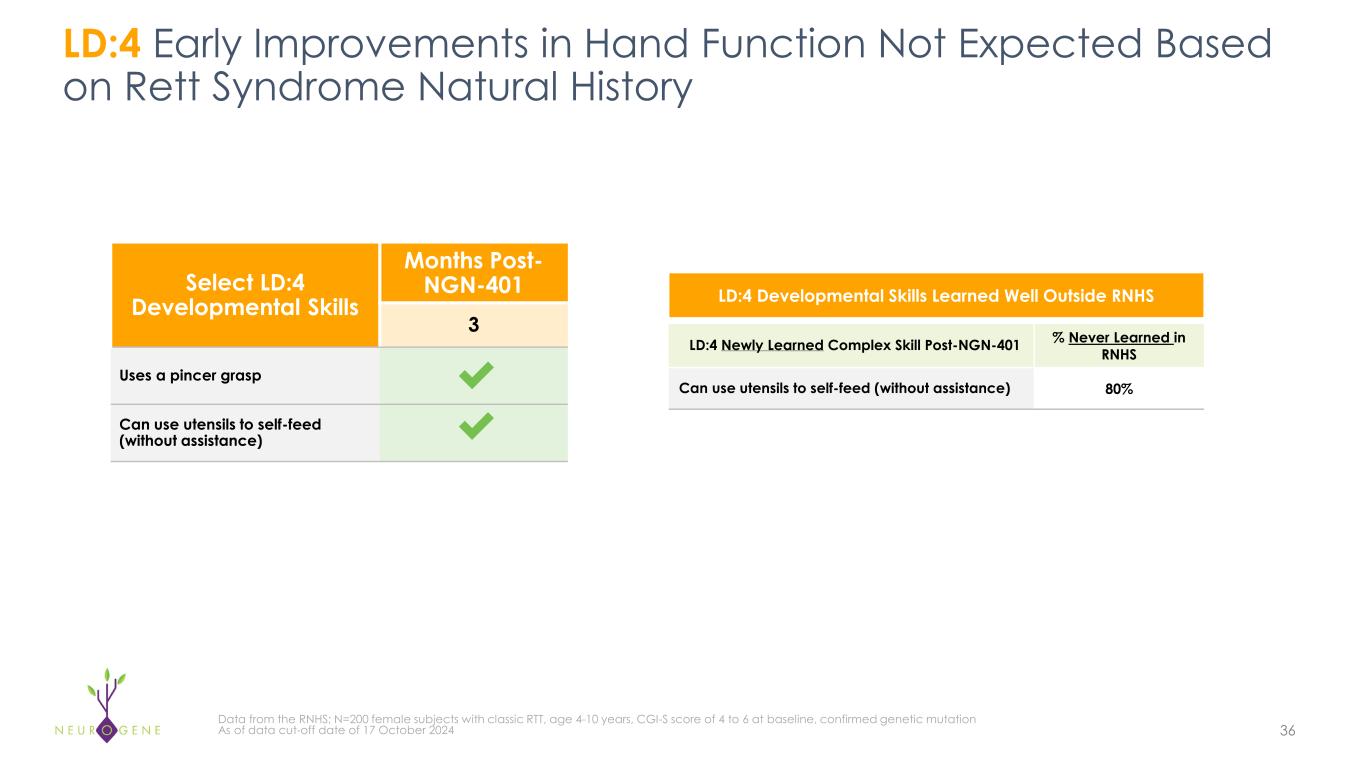
LD:4 Early Improvements in Hand Function Not Expected Based on Rett Syndrome Natural History 36 Select LD:4 Developmental Skills Months Post- NGN-401 3 Uses a pincer grasp Can use utensils to self-feed (without assistance) Data from the RNHS; N=200 female subjects with classic RTT, age 4-10 years, CGI-S score of 4 to 6 at baseline, confirmed genetic mutation As of data cut-off date of 17 October 2024 LD:4 Newly Learned Complex Skill Post-NGN-401 % Never Learned in RNHS Can use utensils to self-feed (without assistance) 80% LD:4 Developmental Skills Learned Well Outside RNHS

Neurogene: Differentiated Clinical-Stage Company Utilizing EXACT Technology to Treat Complex Neurological Diseases 37 • Potential best-in-class efficacy: Durable and concordant improvements observed across multiple scales, incl. two-point improvement in CGI-I in all participants • Consistent gains observed across core clinical domains incl. hand function, gross motor, communication and autonomic function • Favorable safety profile with low-dose NGN-401 • START Pilot Program: provides clear communication channel with FDA to accelerate registrational planning • RMAT designation: eligibility for Accelerated Approval pathway and rolling BLA and potential for Priority Review NGN-401: Best-in-Class Potential w/ Compelling Interim Data Expedited Regulatory Path for NGN-401 via START and RMAT • FDA alignment on CMC potency assay strategy and manufacturing scale-up planning • Initiated adolescent/adult high-dose cohort • Registrational study planning underway Recent Accomplishments Wholly-owned and fully integrated in-house manufacturing capabilities designed for commercial scale As of data cut-off date of 17 October 2024

Next Steps

Key Upcoming Anticipated Milestones and Pipeline Developments Rett syndrome (NGN-401) Expand ongoing Phase 1/2 clinical trial in 1H:24 to enroll a larger cohort of pediatric patients Interim Phase 1/2 clinical data in pediatrics in 4Q:24 Complete low-dose enrollment in pediatrics in 4Q:24 (N=8) Provide regulatory update in 1H:25 regarding pivotal trial design Announce additional Phase 1/2 clinical data in 2H:25 Early-stage discovery Advance one program into the clinic (2025) 39

Thank You
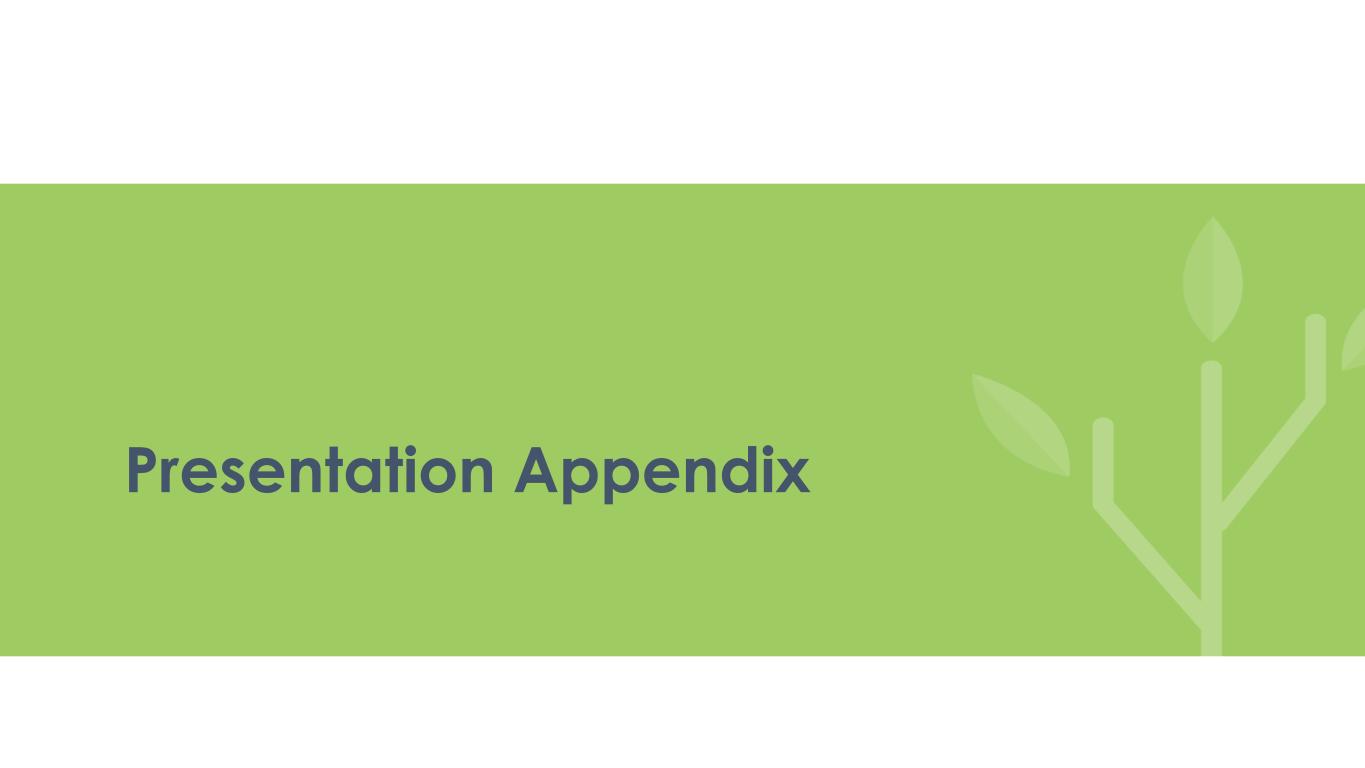
Presentation Appendix
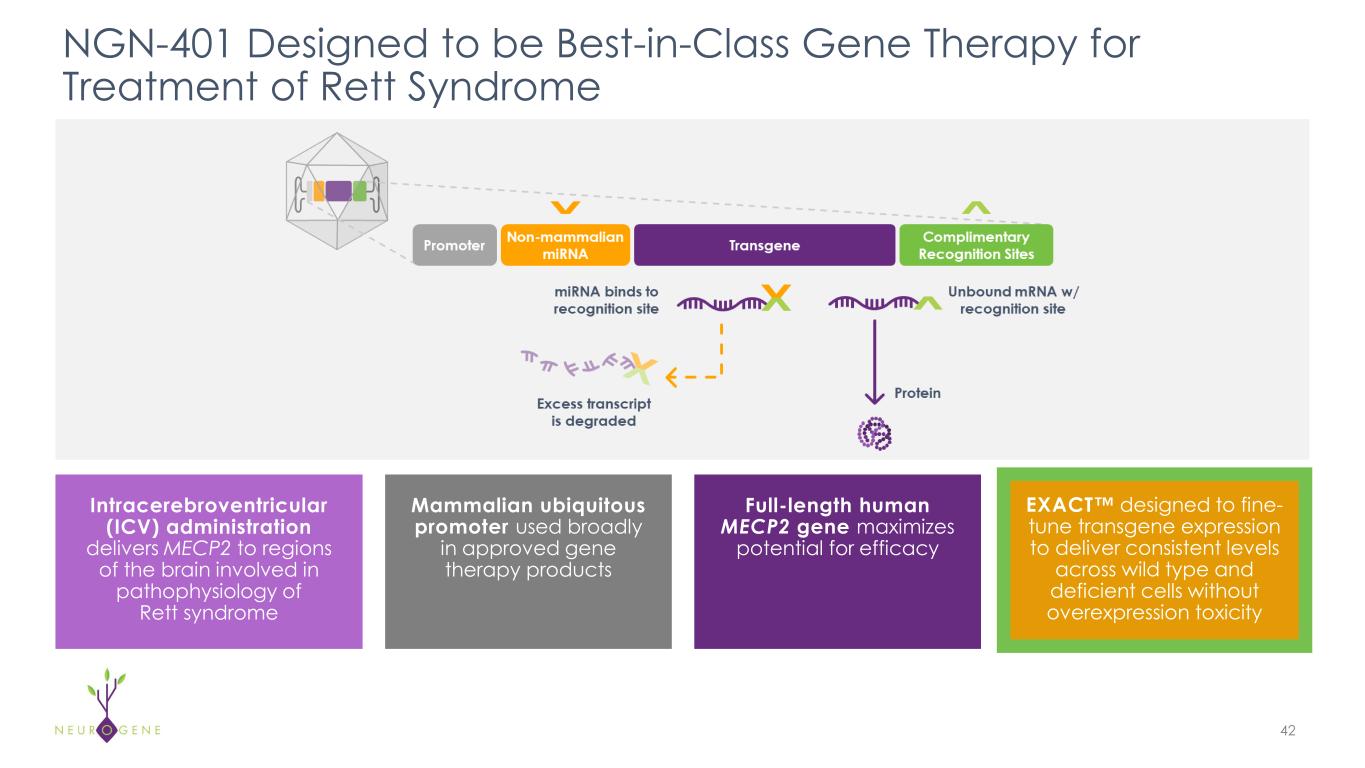
NGN-401 Designed to be Best-in-Class Gene Therapy for Treatment of Rett Syndrome 42 Full-length human MECP2 gene maximizes potential for efficacy EXACT designed to fine- tune transgene expression to deliver consistent levels across wild type and deficient cells without overexpression toxicity Intracerebroventricular (ICV) administration delivers MECP2 to regions of the brain involved in pathophysiology of Rett syndrome Mammalian ubiquitous promoter used broadly in approved gene therapy products
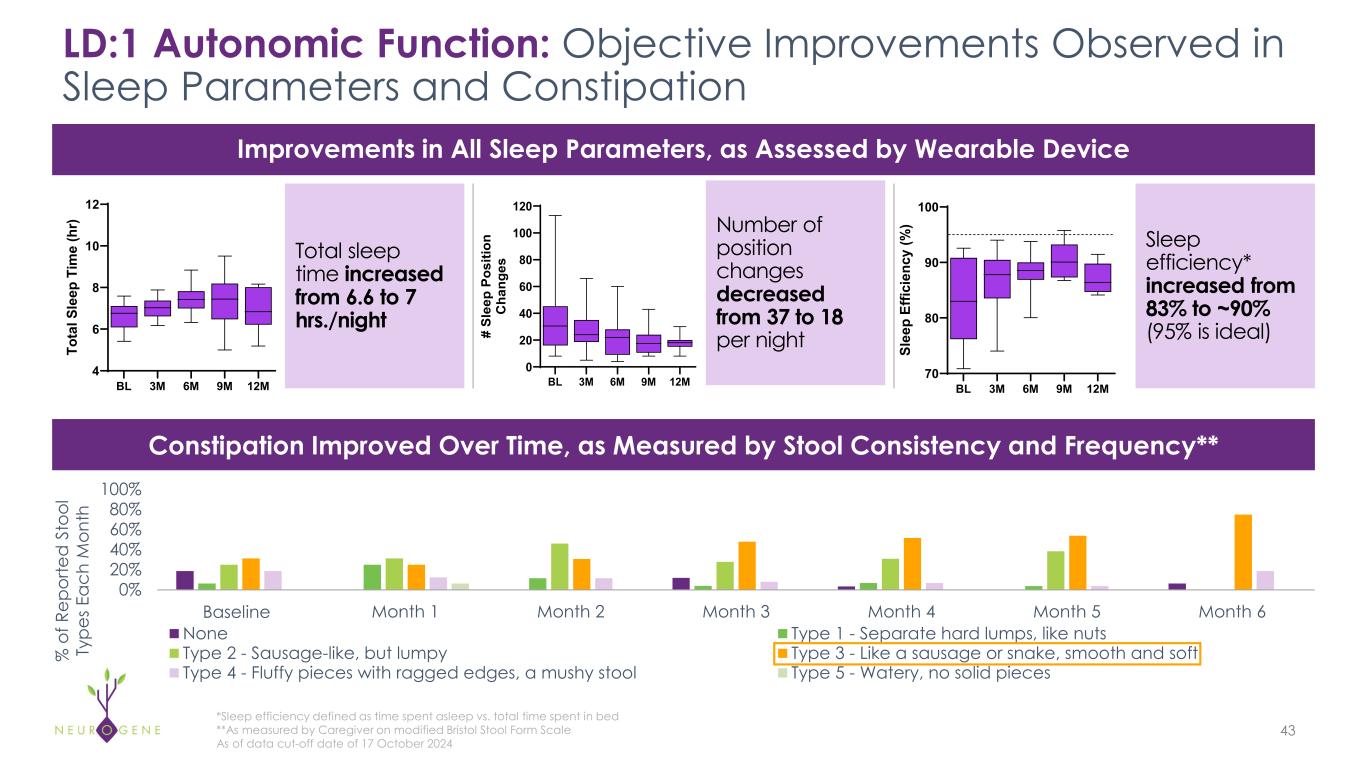
LD:1 Autonomic Function: Objective Improvements Observed in Sleep Parameters and Constipation 43 Total sleep time increased from 6.6 to 7 hrs./night Number of position changes decreased from 37 to 18 per night Sleep efficiency* increased from 83% to ~90% (95% is ideal) Improvements in All Sleep Parameters, as Assessed by Wearable Device Constipation Improved Over Time, as Measured by Stool Consistency and Frequency** % o f R ep or te d S to ol Ty pe s E ac h M on th 0% 20% 40% 60% 80% 100% Month 0 Month 1 Month 2 Month 3 Month 4 Month 5 Month 6 None Type 1 - Separate hard lumps, like nuts Type 2 - Sausage-like, but lumpy Type 3 - Like a sausage or snake, smooth and soft Type 4 - Fluffy pieces with ragged edges, a mushy stool Type 5 - Watery, no solid pieces Baseline BL 3M 6M 9M 12M 4 6 8 10 12 To ta l S le ep T im e (h r) BL 3M 6M 9M 12M 0 20 40 60 80 100 120 # Sl ee p Po si tio n C ha ng es BL 3M 6M 9M 12M 70 80 90 100 Sl ee p Ef fic ie nc y (% ) *Sleep efficiency defined as time spent asleep vs. total time spent in bed **As measured by Caregiver on modified Bristol Stool Form Scale As of data cut-off date of 17 October 2024

0% 20% 40% 60% 80% 100% Month 0 Month 1 Month 2 Month 3 Month 4 Month 5 Month 6 None Type 1 - Separate hard lumps, like nuts Type 2 - Sausage-like, but lumpy Type 3 - Like a sausage or snake, smooth and soft Type 4 - Fluffy pieces with ragged edges, a mushy stool Type 5 - Watery, no solid pieces LD:2 Autonomic Function: Objective Improvements Observed in Sleep Parameters and Constipation 44 Transition to More Restful Sleep, as Assessed by Wearable Device Constipation Improved Over Time, as Measured by Stool Consistency and Frequency** Total sleep time decreased; however, more restful sleep occurring Number of position changes decreased from 37 to 8 per night Sleep efficiency* increased to >95%, which is ideal % o f R ep or te d S to ol Ty pe s E ac h M on th BL 3M 6M 9M 4 6 8 10 12 To ta l S le ep T im e (h r) BL 3M 6M 9M 0 20 40 60 80 100 120 # Sl ee p Po si tio n C ha ng es BL 3M 6M 9M 70 80 90 100 Sl ee p Ef fic ie nc y (% ) Baseline *Sleep efficiency defined as time spent asleep vs. total time spent in bed **As measured by Caregiver on modified Bristol Stool Form Scale As of data cut-off date of 17 October 2024
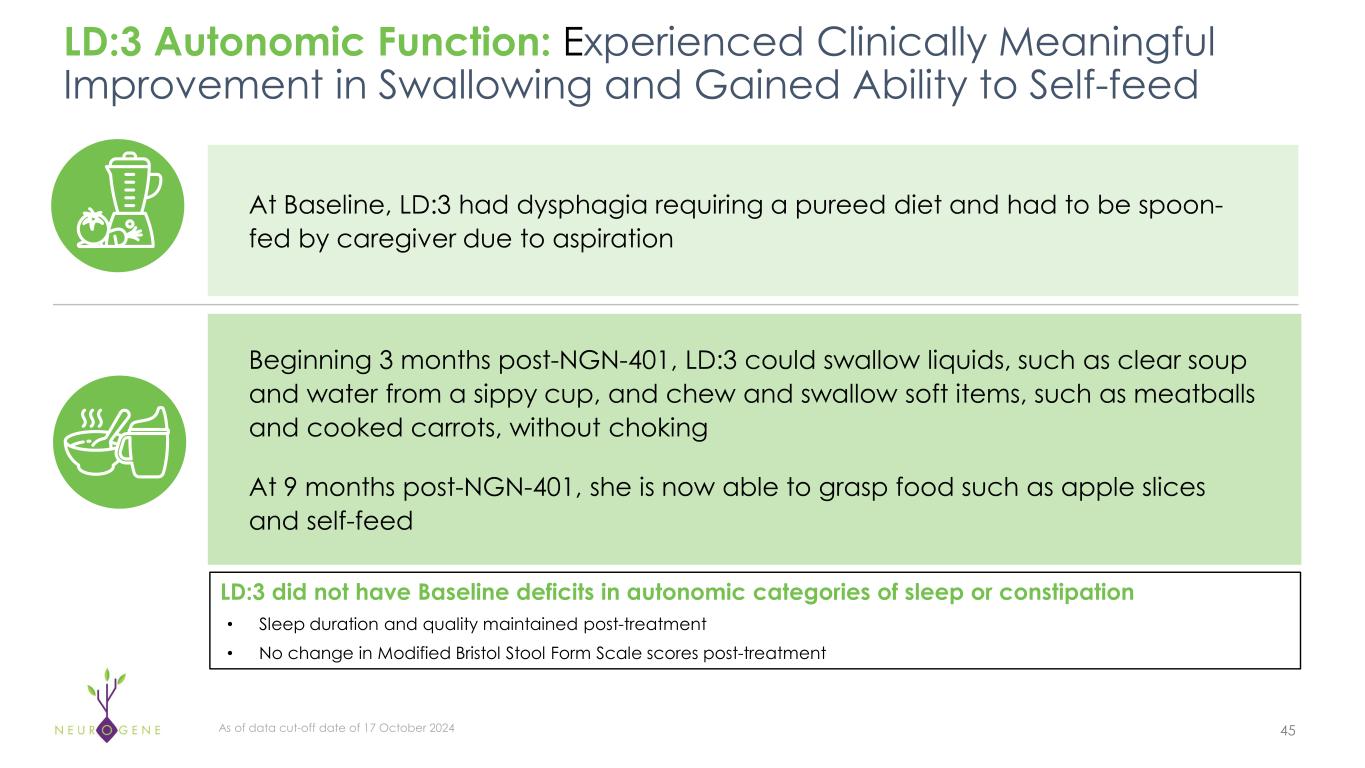
Beginning 3 months post-NGN-401, LD:3 could swallow liquids, such as clear soup and water from a sippy cup, and chew and swallow soft items, such as meatballs and cooked carrots, without choking At 9 months post-NGN-401, she is now able to grasp food such as apple slices and self-feed At Baseline, LD:3 had dysphagia requiring a pureed diet and had to be spoon- fed by caregiver due to aspiration LD:3 Autonomic Function: Experienced Clinically Meaningful Improvement in Swallowing and Gained Ability to Self-feed 45 LD:3 did not have Baseline deficits in autonomic categories of sleep or constipation • Sleep duration and quality maintained post-treatment • No change in Modified Bristol Stool Form Scale scores post-treatment As of data cut-off date of 17 October 2024
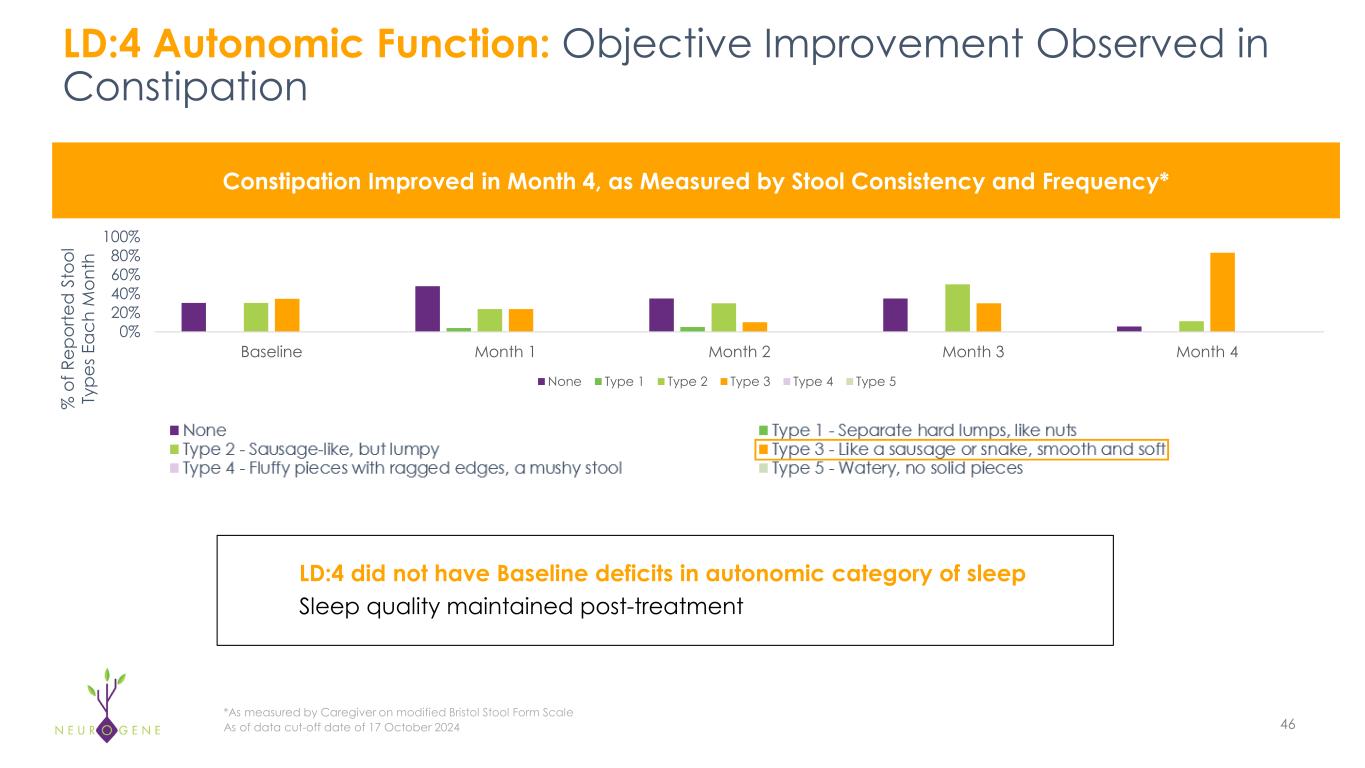
LD:4 did not have Baseline deficits in autonomic category of sleep Sleep quality maintained post-treatment LD:4 Autonomic Function: Objective Improvement Observed in Constipation 46 Constipation Improved in Month 4, as Measured by Stool Consistency and Frequency* *As measured by Caregiver on modified Bristol Stool Form Scale 0% 20% 40% 60% 80% 100% Baseline Month 1 Month 2 Month 3 Month 4 None Type 1 Type 2 Type 3 Type 4 Type 5 % o f R ep or te d S to ol Ty pe s E ac h M on th As of data cut-off date of 17 October 2024













































